Today’s Chinese PLAN (2023)
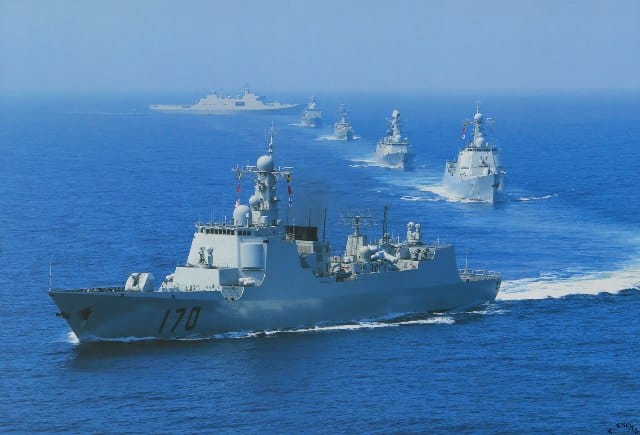
500,000 tonnes, 550 ships, world’s largest fleet by number, not tonnage.
October’s special !
Both at the occasion of the China national day, and due to steaming hot tensions around Taiwan, here is an exceptional overview of the modern Chinese PLAN, assorted with a “real thing” poster to help figuring out the true scale of Xi’s PLAN today (including projected ships for 2023-2026).
China had awakened: Xi’s master ace for the decade
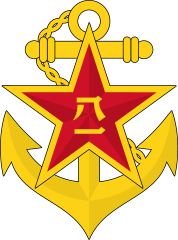 In the 1950s there were concerns about China great “awakening”, with the biggest population and the highest potential of any developed Asian nations. Since 1990 and the end of the bipolar threat, China has the ambition to create a blue water navy of such importance that it is rated nowadays the #1 concern for global American Strategic thinking. Ranking #2 just behind the US Navy, the PLAN (People’s Liberation Army Navy) is resolutely Adopting a more active, ambitious, even aggressive stance, according to increasingly worrying Asian neighbors.
In the 1950s there were concerns about China great “awakening”, with the biggest population and the highest potential of any developed Asian nations. Since 1990 and the end of the bipolar threat, China has the ambition to create a blue water navy of such importance that it is rated nowadays the #1 concern for global American Strategic thinking. Ranking #2 just behind the US Navy, the PLAN (People’s Liberation Army Navy) is resolutely Adopting a more active, ambitious, even aggressive stance, according to increasingly worrying Asian neighbors.
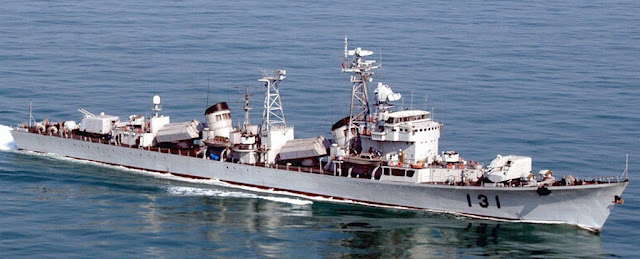
Luda class missile destroyers, the backbone of the Cold war Chinese PLAN (cdts: )
Regional Tensions
There are tensions and concerns about the South China Sea, East China Sea EEZ, and Paracel Islands. Territorial disputes which concerns also Brunei, Malaysia, the Philippines, Taiwan, and Vietnam, all navies that were comprehensively modernized since the 2000s, with much larger budgets. There are major tensions (new “incidents” are for the moment not excluded) towards the Senkaku Islands (Diaoyu), with a considerably reinforced JSDNF. Since commercial lines and Chinese oil supplied passes through the Indian Ocean, the Indian Navy also considerably reinforced its potential recently (an incident occurred already off the Vietnam coast with the INS Airavat in 2011).
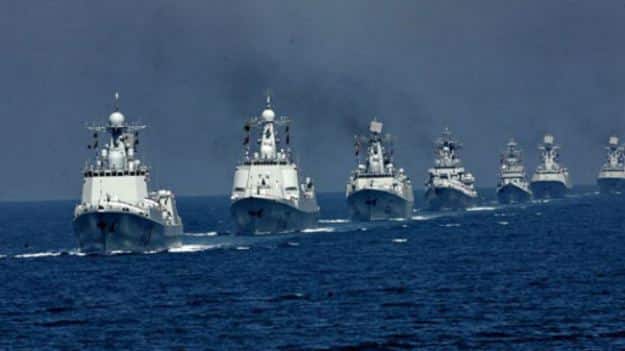
Anti-Piracy Missions
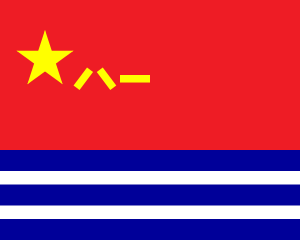
Naval ensign of China
On a more positive side, the Chinese Navy also participates actively to anti-piracy operations, a good way to train personal and justify the Navy’s growing budget but moreover safeguard trade routes. A massive deployment started on 18 December 2008 in Aden’s Gulf, in response to Somali pirates attacks on Chinese ships and hijacking attempts. Since then, more than 30 ships had been deployed in this area to this day. One ship also took part in the Libyan civil war, and another had some role in the Yemen conflict, in both case performing evacuation of nationals and not nationals like Pakistani personal.
Strength Today
The PLAN is in a transition phase from an essentially coastal defense navy in 1990 towards a blue water navy of comparable assets to the US Navy in this area. This goes in par with the building of new aircraft carriers (the first of which is the unnamed yet 001A), and a fleet of modern destroyers with a comparable to the US/Japan AEGIS type system to defend these task forces.
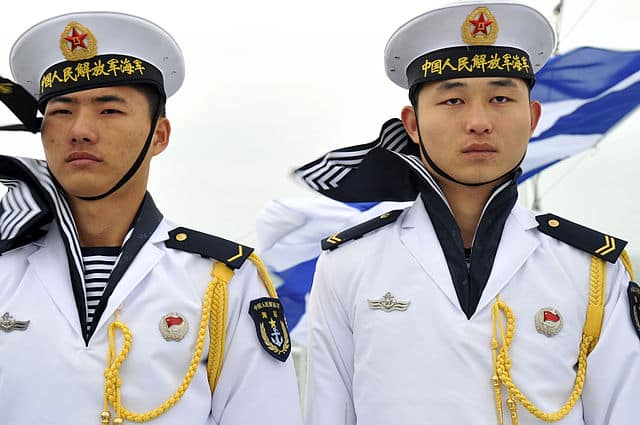
From 2012 the asserted strength of the PLAN is about 280,000 personnel and approx. 500 ships excluding auxiliaries) and 700+ aircrafts, including carried helicopters and long-range naval planes. The Navy is divided into five branches: The Submarine Force, the Surface Force, the Coastal Defense Force, the Marine Corps (personal 10,000, well equipped) and the Naval Air Force (26,000 by 2015).
The PLA Navy Headquarters directly under the Central Military Commission of the Communist Party. Actual Commander is Vice Admiral Shen Jinlong, assisted by Political Commissar Admiral Miao Hua.
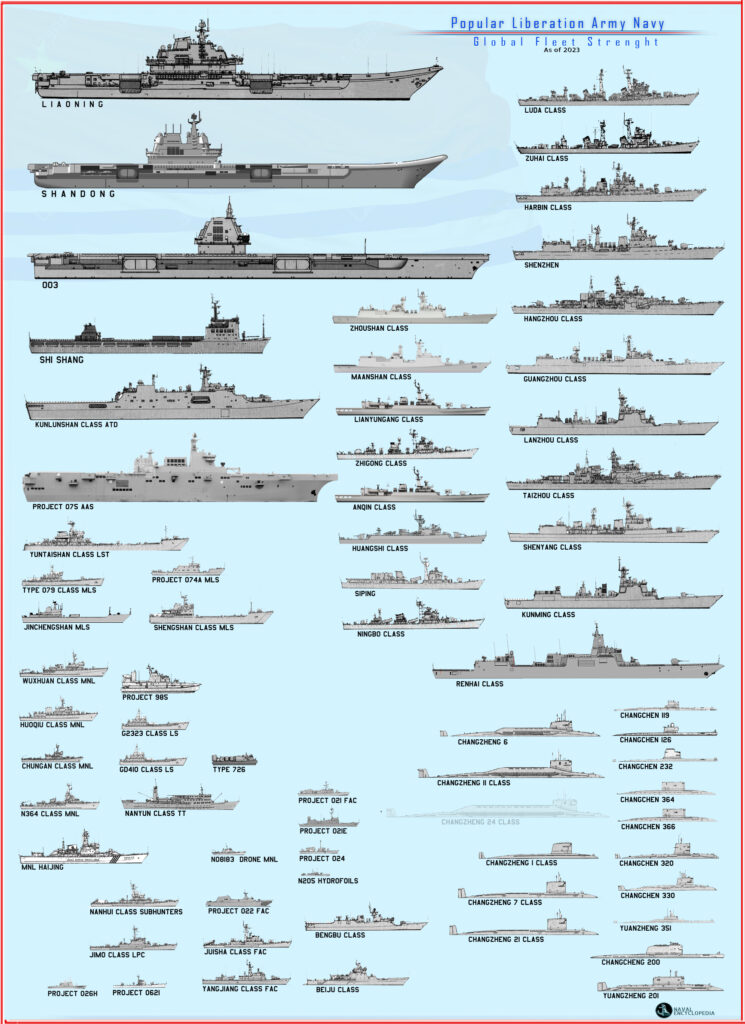
NE’s rendition of the PLAN in 2023, by class
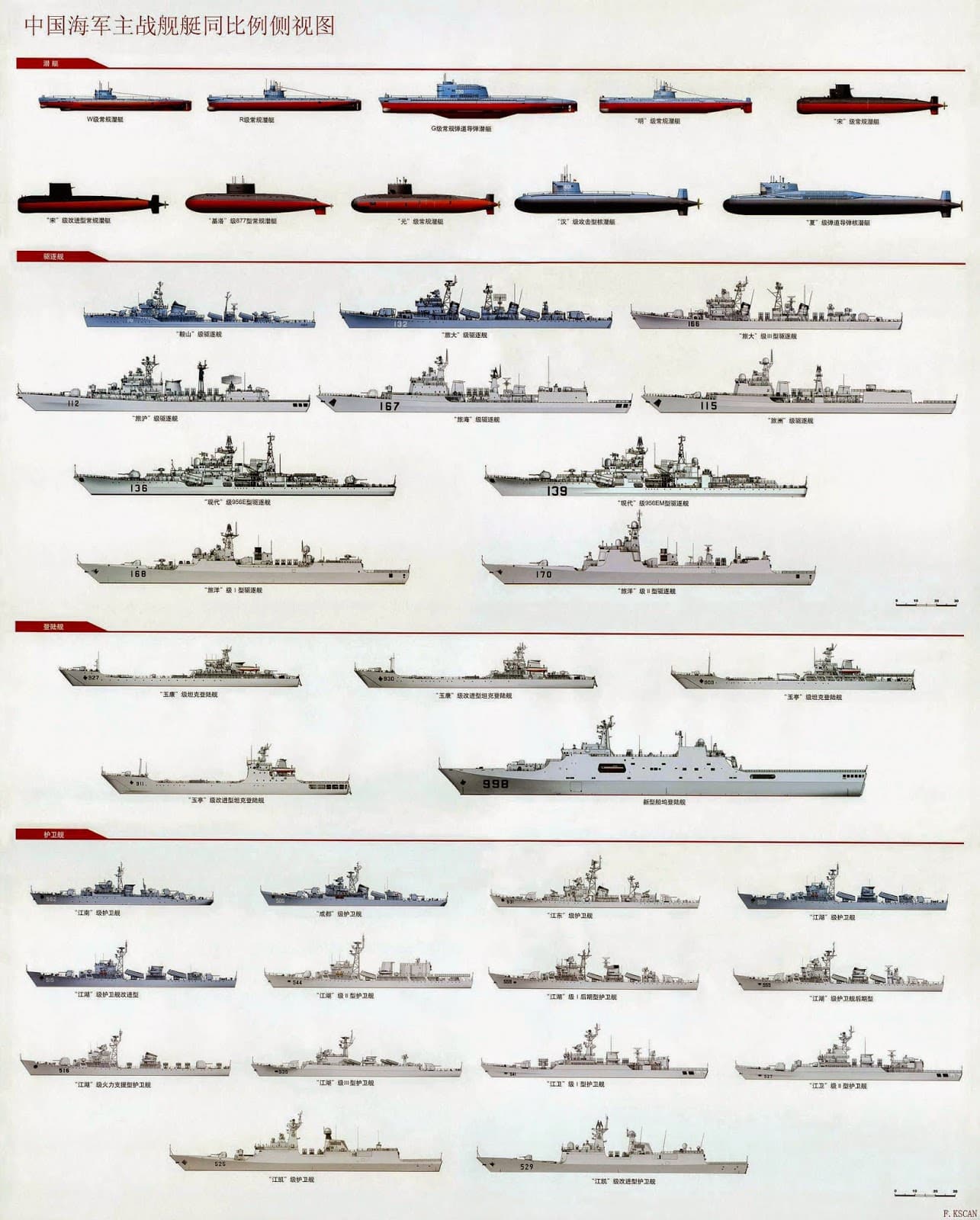
Poster of Chinese PLAN ships – Retrieved from http://navalanalyses.blogspot.fr
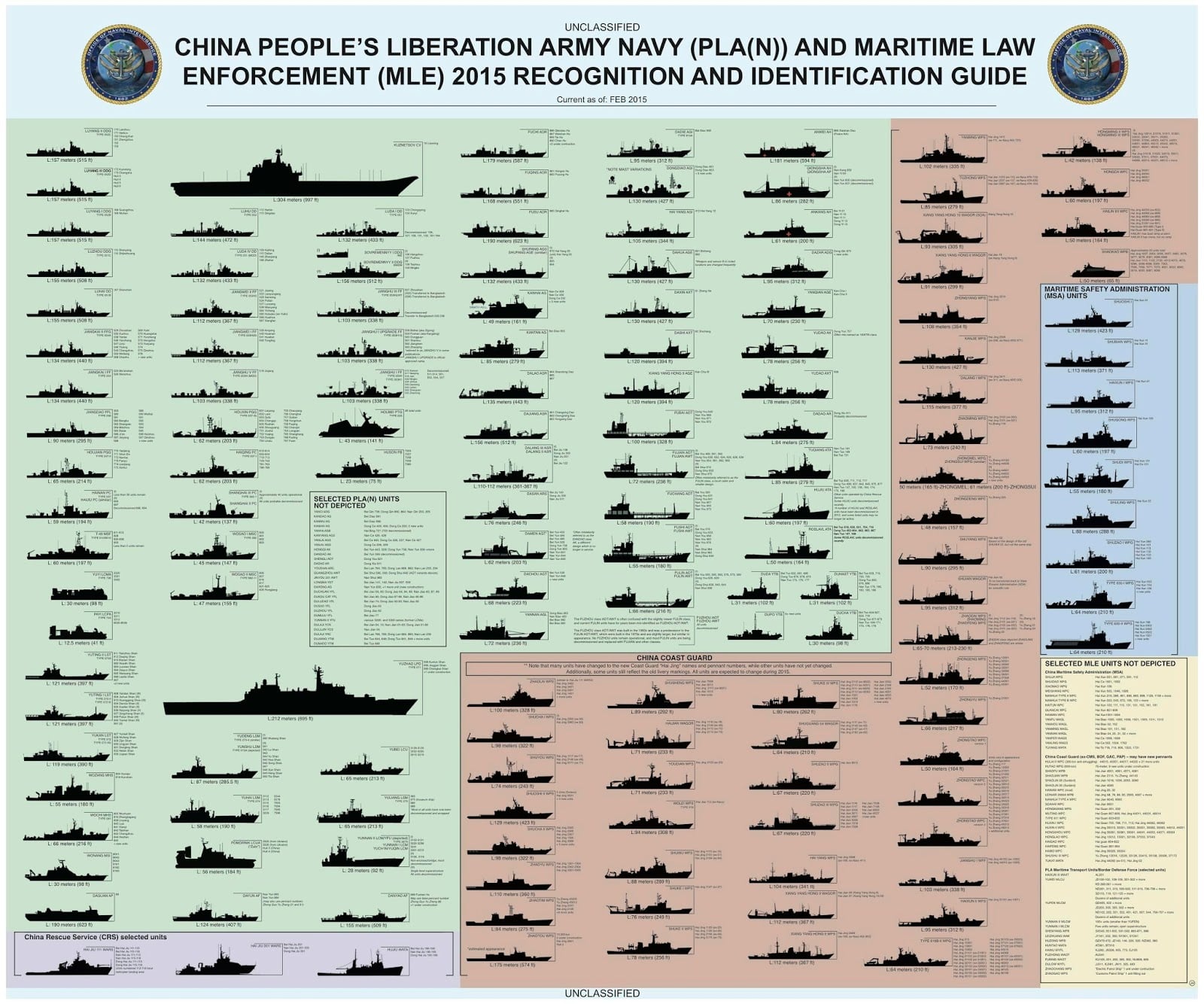
In the wake of the release of The PLA Navy: New Capabilities and Missions for the 21st Century by U.S. Office of Naval Intelligence (ONI) in April 2015, released publicly a comprehensive identification & recognition guides of China’s PLAN and Maritime Law Enforcement (MLE) ships.
Compared fleets |
|||
| Types | |
||
| Aircraft Carriers | 2(+1) | 4* | 11 |
| Cruisers | 8** | 0 | 13 tico |
| Destroyers | 42 | 36 | 75 (3 Zumwalt) |
| Frigates | 43 | 10 | 24*** |
| Corvettes | 72 | 6**** | 0 |
| Amphibious Ships (LHDs/LST/Ms) | 82 | 4 | 64***** |
| Missile attack crafts | 107 | 0 | 0 |
| Sub Chasers | 26 | 0 | 0 |
| Mine warfare vessels | 0 | 30 | 8 |
| Nuclear Submarines | 19 | 0 | 68 |
| Conventional Submarines | 58 | 22 | 0 |
| Miscellaneous | c240 | 35 | 40+ |
*officially designated as “helicoper destroyers” but scheduled to receive the F-35 Lighting II
**Type 055 are cruisers by NATO standard, large destroyers for PLAN
***Freedom and Independence class LCS
****class as destroyer escorts
*****17 LHDs, 30 LPDs, 17 LSDs
A seen above the Chinese Navy’s combined corvette+frigate+destroyer force is now superior to either the USN or the JMSDF, Chinese carriers are also superior in capabilities to the Japanese vessels, and the JMSDF being traditionally defense-oriented has a very limited amphibious component. On this chapter the USN had still a clear advantage over the PLAN with thrice as much LHDs and generally larger LHDs/LSDs. And it doesn’t includes is still large LST force. But the most striking point is the Chinese strenght in “green water navy” assets (large and small OPVs, FACs, sub chasers, auxiliaries), which explained its world’s largest tonnage. And i did not included the coast guard here. The Chinese one is on par with the USCG. This part will be developed in detail in the coming months.
Fleets & Naval bases
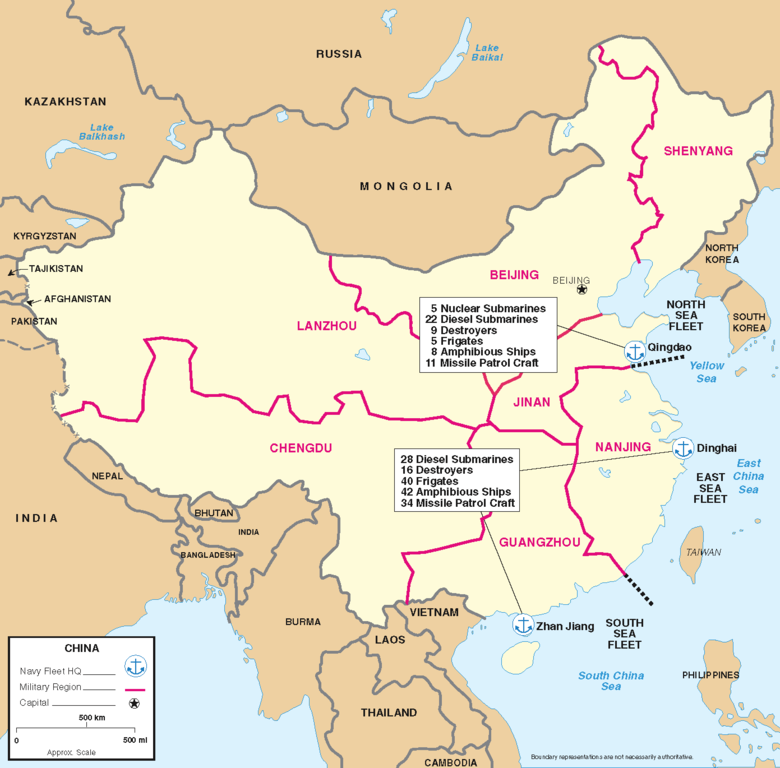
Chinese military regions showing the three regional fleets.
Three fleets:
The North Sea Fleet:
Yellow Sea headquartered in Qingdao, Shandong Province.
Local yards and bases are Dalian, Jinxi, Jiyuan, Laiyang, Jiaoxian, Xingtai, Laishan, Anyang, Changzhi, Liangxiang and Shan Hai Guan.
The East Sea Fleet:
East China Sea headquartered in Ningbo, Zhejiang Province.
Local yards and bases are Danyang, Daishan, Shanghai (Dachang), Luqiao, Feidong and Shitangqiao.
The South Sea Fleet:
South China Sea headquartered in Zhanjiang, Guangdong Province.
Local yards and bases are Foluo, Haikou, Lingshui, Sanya, Guiping, Jialaishi and Lingling.
These bases includes the Chinese naval air service.
Each fleet comprises surface forces and submarine forces, coastal defence units and aircraft attached. It’s a bit of a reminder of the system of four ancient Qing dynasty imperial fleets, a century before. The Beiyang fleet (1871) decimated at Yalu was yet reputed the strongest of the three (and of Asia), even stronger than the IJA. It was the ancestor of the “northern fleet”, now the north sea fleet. Aircraft carriers are not part of the mix now. The only one in service (The Liaoning) is currently not attached to any fleet, since it’s used for instruction, but deployed over the years in all three. The second aircraft carrier currently in building (still unnamed) is not scheduled to be attached to any fleet yet. Three are needed to create the expected local task forces.

The most outstanding recent naval base built by he PLAN is certainly the Underground nuclear submarine base near Sanya, Hainan. It is also called Longpo peninsula base, part of the Yulin Naval Base complex. Modified to protect nuclear submarines from a nuclear attack, it is situated along the southern coast of Hainan, reported by several intelligence agencies, and so far satintel revealed Shang-class submarines were “stored” there, but the base had natural cavenrs reconfigured to house up to 20 SSNs/SSBNs. The harbor meanwhile is for SSBNs and large enough to accommodate aircraft carriers. It is estimated six Type 094 SSNs shoukd be located there. There are two 950 m piers, three smaller ones for two carrier strike groups or amphibious assault ships.
The coast guard
The PLAN paramilitary maritime service is chiefly the China Coast Guard. Previously part of the provincial armed police border defense force command, it was reorganized and consolidated as an unified service. It includes the China Marine Surveillance (CMS) and Hai Guang, or People’s Armed Police and sea militia. The CMS first primary duties are coastal and ocean search and rescue or patrols.
While Hai Guang operates hundreds of local small patrol craft for maritime patrol, the CMS uses larger, long range ships ships armed often with machine guns and 37mm antiaircraft guns supported by small aviation units whereas Hai Guang operates a fleet of Harbin Z-9 helicopters, and Harbin Y-12 STOL modified patrol planes.
Coastal provinces had one to several Coast Guard squadrons, such as Fujian, Guangdong (3 squadrons), Liaoning, Shandong, Zhejiang, Hainan, Guangxi (2 each), or Heibei, Tianjin, Jiangsu, Shanghai (1 each).
Shipyards
–Jiangnan Shipyard (Group) Co. Ltd:
–Dalian Shipbuilding Industry Company:

The new Type 055 destroyers are the most ambitious so far. (credits junshicg.com).
Chinese PLAN Current Amphibious Forces
Battle Order (PLAN Amphibious vessels)
Each class would be detailed further down, but the current strenght of the amphibious forces rests on two components:
-A primary PLAN force composed of 10 amphibious transport docks, 38 landing ship tanks and 34 landing ship mediums. This excludes all smaller landing crafts and hovercrafts (they are part of 240 “auxiliaries”).
-An auxiliary landing force composed of requisitioned civilian ships. It is composed of about 30 large civilian RO-ROs. According to CSIS, by 2026, the Chinese would be able to muster 8 LSTs, 18 LHD/LPDs, 20 LSMs (and the 30 large civilian RO-ROs) for a total of 96 ships serviced by 305 landing craft, and this includes hovercrafts.
Chinese LCACs
On this chapter, numbers are ellusive, notably due to constant pennant changes and non communicated numbers. So perhaps more than a hundred LCACs could be available today already, of the Type 711
Type 716 (Dagu A class), Type 716II (Dagu B class), Type 722 (Jingsah I class), Type 722II (Jingsah II class), Type 724 LCAC Songling class, Type 726 LCAC Yugi class, and requisitionable civilian Types. https://www.secretprojects.co.uk/threads/chinese-hovercraft.21344/ The crowning jewel are the few super-heavy ex-Zubr class (2 delivered by Ukraine, 2 built in China) src
Chinese auxiliary Ro-Ros
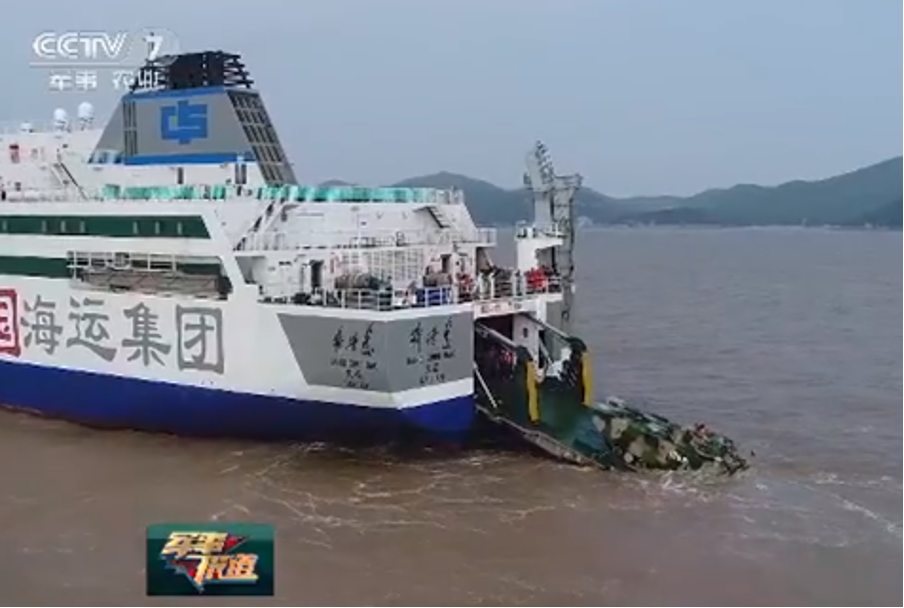
CCTV coverage showing amphibious recovery in 2019. CCTV Image via The James Foundation and UNSI.org
A good example could be the Type 701 roll-on/roll-off ship. Built at Songliao Shipyard in 2013, this 3500 tonnes vessels has been photographed but information is purely conjectural. This auxiliary ship currently in service comprised just two ship in this class, confirmed in service as of mid-2010s. They are not listed with the PLAN but the People’s Liberation Army Ground Force (PLAGF). Born from Dalian Songliao Shipyard under the direct control of Department of Equipment of Shenyang Military Region, they are called officially as translated the “Integrated Training Ships” when the order was placed in 2011 and now are categorized officially as roll-on/roll-off ships.
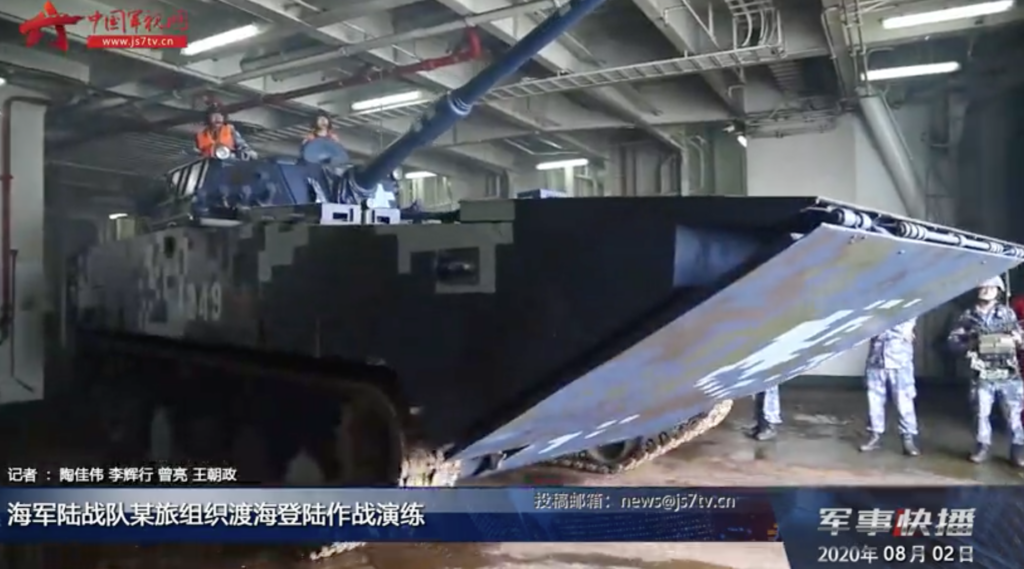
A Chinese amphibious armored vehicle leaving the car ferry Bang Chui Dao in 2020. CCTV image
They had been spotted in numerous joint training maneuvers with PLAN and seeing PLAN helicopter operations from October 2014 form combined arms exercizes. Both ships has a landing pad, but likely no hanger. The Type 701 has two funnel arguing for marine diesel engines and they have a bow door, and by size are likely to land 24 armored fighting vehicles of common PLA types.
These are civilian ships yet in some aspects, and they served in this role when not in use with the PLAN, armed with two twin 14.5 mm machine guns. No NATO class name associated so far.
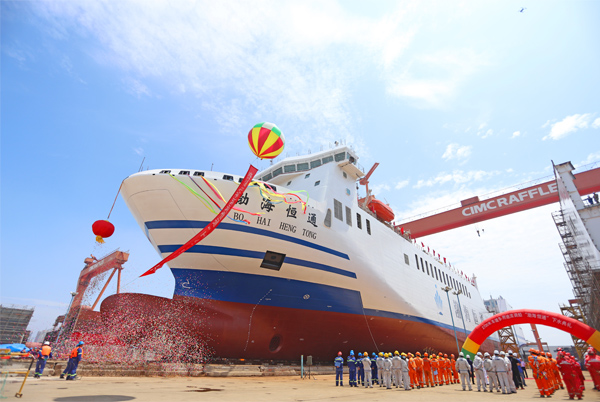
But these are no alone, they are quite impressive civilian ships that can also be used in military roles once converted, clearly identified as potential auxiliaries such as the RoRo ferry Bo Hai Heng Tong class, two 15,000-ton multipurpose cargo ships with 1.6 miles long, three meters tall, three decks level park, a cargo capacity almost three times that of a San Antonio-class amphibious warship (LPD-17). They are ignificant in more than one traits: Asia’s Largest Multipurpose Ro-Ro Ship built by CIMC Raffles, “Bohai Hengtong” has indeed not only generous size (full specs on the official site),and these multipurpose ships were designed from the outset to carry all current military vehicle types (a ZLT-05 barely made is inside one of the three decks) and also can carries modular containers in an addition t an unusual feature for this tupe, a large large helicopter landing deck with four spots. They were used quite officially for manoeuvers with the PLAN less than a month after U.S. House Speaker Rep. Nancy Pelosi visited Taiwan…
NATO still has skepticism about these ships, and despite the use of specially designed civilian Ro-Ro ships for amphibious assaults, ability to use these for amphibious assaults could be doubted as they still provides a slow rate of offloading, there has been many example of landing failures due to slow pace 1
Chinese Marines
 The People’s Liberation Army Navy Marine Corps was originally created in the 1950s, reorganized in 1979 and as of 2019 represented a force of 12,000 marines, two 6000 strong Marine brigades based in the South China Sea and attached to the South Sea Fleet. They are obviously tailored and trained for the invasion of Taiwan. Considered elite troops they are early for quick mobilization, trained to amphibious warfare with Paratroopers and acting as fighting spearhead. The current doctrine is for them to open a bridgehead and enable enough time for the Army (PLA) to then ship its own divisions and reinforce it. Thus they are also the best equipped infantry in China (apart special operation units), between the Type 95 Assault Rifle and other small arms, mortars, light artillery, and an armoured component plus dedicated air support, plus now a rapidly growing first rate amphibious assault fleet.
The People’s Liberation Army Navy Marine Corps was originally created in the 1950s, reorganized in 1979 and as of 2019 represented a force of 12,000 marines, two 6000 strong Marine brigades based in the South China Sea and attached to the South Sea Fleet. They are obviously tailored and trained for the invasion of Taiwan. Considered elite troops they are early for quick mobilization, trained to amphibious warfare with Paratroopers and acting as fighting spearhead. The current doctrine is for them to open a bridgehead and enable enough time for the Army (PLA) to then ship its own divisions and reinforce it. Thus they are also the best equipped infantry in China (apart special operation units), between the Type 95 Assault Rifle and other small arms, mortars, light artillery, and an armoured component plus dedicated air support, plus now a rapidly growing first rate amphibious assault fleet.
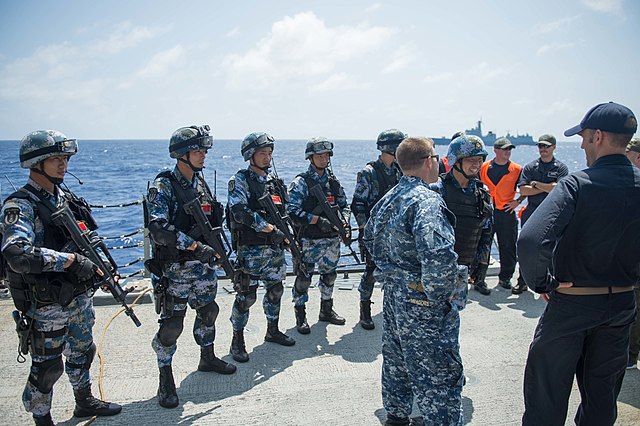
Chinese PLAN Marines at RIMPAC
It was clearly geared towards the creation of a powerful offshore expeditionary force, but for this, the naval program needs to extend its construction schedule to even more ships (see later) as to this day (2023) analysts says invasion scenarios envision a fulcrum with PLAN dedicated assault/amphibious ships (it is yet to determine if they can lands 16,000+ men in 48th) followed by massive PLA reinforcements brought by requisitioned civilian ships of the “Ro-Ro” type.
Organization
18,000 marines currently are available for the Southern Theater Command, 6,000 under the Eastern Theater Command, 12,000 being under the Northern Theater Command. It is likely in case of an invasion of Taiwan, at least a part of both brigade’s strenght would be also mobilized as second échelon so 16,000 active frontline combatants is the theoretical total than can be thrown on the beach over 72h of all rotations are working like clockwork, later to be beefed up by PLA divisions. These brigades of combined arms all are well equipped with armor, artillery, missile, air defense, and logistics. There is no real dedicated armour in the sense that vehicles are all PLA models, at the exception of the ZBD-2000 which is specifically for the Marines (c800 extant). It is notewhorthy faster for example than the current USCM AA7V amphibious tracked vehicle.
-1st and 2nd (ex-164th) Marine Brigades Zhanjiang
-3rd Marine Brigade Jinjiang
-4th Marine Brigade Jieyang
-5th Marine Brigade Laoshan
-6th Marine Brigade Haiyang
Composition of each brigade
One Brigade HQ and Service Company
Three Marine Combined Arms Battalion (1x ZTD-05 Tank bat., ZBD-05 Amphibious IFV bat. VP4 ATV bat*.)
One Air Assault Battalion
One Marine Artillery Battalion
One Air Defense Battalion
One Marine Reconnaissance Battalion
One Combat Support Battalion
One Service Support Battalion
*Respectively the heavy, medium and light batallions.
PLAN Marine Corps are composed of light infantry, and supplements the armoured amphibious combined-arms brigades and due to the joint-operation command structure, the Marine Corps establishes landing parameters before ground force offensive.
Armored and Vehicle Component

Marines Type 86 IFV Type 86 Infantry Fighting Vehicle (now in reserve)
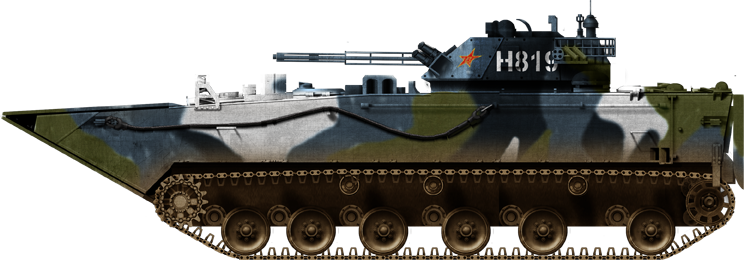
Marines amphibious ZBD-05 Infantry Fighting Vehicle
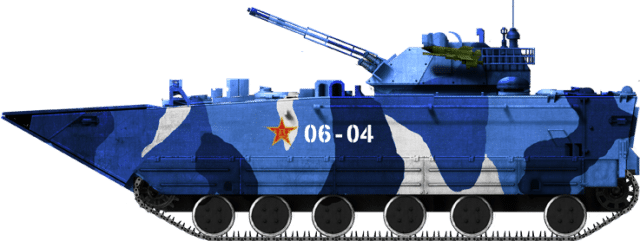
Marines amphibious ZBD-2000 Infantry Fighting Vehicle
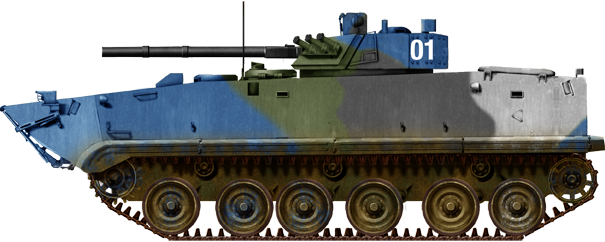
Marines amphibious ZBD-97 Infantry Fighting Vehicle, Author’s illustration.
⚯ Tanks and AFVs of modern china
Chinese PLAN’s Air Force
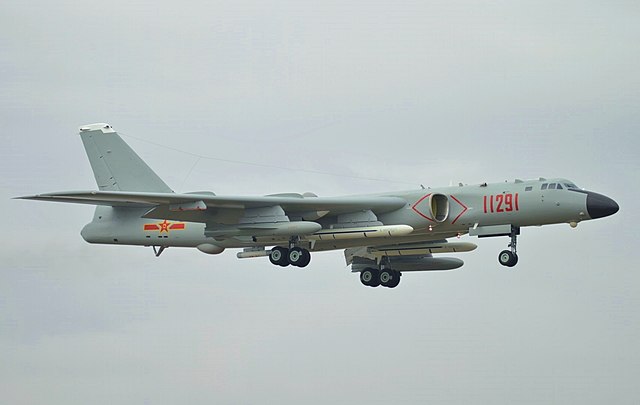
Xia H-6 naval bomber, a long derived Chinese TU-16 Badger.
The People’s Liberation Army Naval Air Force (PLANAF) is an independent branch of the PLAN with 25,000 personnel, 690 aircraft. Its hardware is shared with the PLAF between carrier fighter, patrol bombers, attack aircraft, tankers and reconnaissance/early warning aircraft as well as electronic warfare aircraft. But also maritime patrol aircraft (including seaplanes) as well as transport aircraft and helicopters for SAR, liaison, plane guard duties, ASW warfare and assault.
Traditionally operating from coastal air bases, the 2000s saw the rapid increas of the park of ship-based models, between the new aicraft carriers, new destroyers and frigates with helicopter cpabilities, and assault ships. Carrier aviation really started to be beefed up from 2012. The PLANAF followes the PLAN organization with based for the North Sea Fleet at Dalian, Qingdao, Jinxi, Jiyuan, Laiyang, Jiaoxian, Xingtai, Laishan, Anyang, Changzhi, Liangxiang and Shan Hai Guan, for the East Sea Fleet at Danyang, Daishan, Shanghai (Dachang), Ningbo, Luqiao, Feidong and Shitangqiao and for the South Sea Fleet at Foluo, Haikou, Lingshui, Sanya, Guiping, Jialaishi and Lingling.
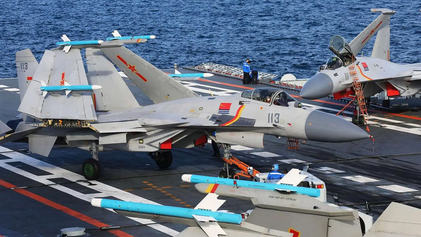
Shenyang J-15 aboard Liaoning in 2017
|
||
Model |
Type | Numbers |
| Xian H-6G/N | Strategic bomber | 45 |
| Xian JH-7/7A | Fighter Bomber | 120 |
| Shenyang J-8H/FH | Interceptor | 24 |
| Chengdu J-10AH/SH | Multirole | 23 |
| Shenyang J-11BH/BSH | Air superiority | 72 |
| Shenyang J-15 | Multirole | 50 |
| Sukhoi Su-30MK2 | Multirole | 24 |
| Shaanxi Y-8J | AEW | 4 |
| Shaanxi Y-8 KJ-200H | AEW | 6 |
| Shaanxi Y-9 KJ-500H | AEW | 14+ |
| Changhe Z-18J | AEW | 2 |
| Kamov Ka-31 | AEW | 9 |
| Xian JH-7B.01 | Tactical reconnaissance | 4 |
| Shenyang J-8F | Tactical reconnaissance | 4 |
| Shaanxi Y-8JB | ELINT | 5 |
| Shaanxi Y-9JZ | ELINT | 8 |
| Shaanxi Y-8X | Maritime patrol aircraft | 3 |
| Shaanxi Y-9KQ-200 | Maritime patrol aircraft | 20+ |
| Xian H-6DU | aerial refueling | 4 |
| Shijiazhuang Y-5C | Transport | 18 |
| Xian Y-7 | Tactical transport | 5 |
| Shaanxi Y-8C | Tactical transport | 30 |
| Harbin Y-12F | Aerial survey | 2 |
| Xian MA60H | Aerial survey | 2 |
| Bombardier CRJ200 | VIP transport | 2 |
| Bombardier CRJ700 | VIP transport | 2 |
| Yakovlev Yak-42D | VIP transport | 2 |
| Changhe Z-8J/JH | ASW | 6 |
| Changhe Z-8 | SAR | 6 |
| Changhe Z-8S | MEDVAC | 4 |
| Harbin Z-9C | ASW | 24 |
| Harbin Z-9D | ASW | 14 |
| Harbin Z-9S | SAR | 2 |
| Changhe Z-18 | Trabsport | 4 |
| Changhe Z-18F | ASW | 2 |
| Kamov Ka-27PS | SAR | 3 |
| Kamov Ka-28 | ASW | 14 |
| SA 321 Super Frelon | ASW | 13 |
| Eurocopter AS565SA Panther | ASW | 6 |
| Nanchang CJ-6A | Basic trainer | 40 |
| Hongdu JL-8H | jet trainer | 32 |
| Guizhou JL-9H | jet trainer | 20 |
| Guizhou JL-9G | Carrier trainer | 16 |
| Hongdu JL-10H | jet trainer | 8 |
| Xian Y-7LH | Navigator/bombardier trainer | 12 |
| Guizhou Sunshine | MALE UAV | 2 |
| Chengdu Pterodactyl I | MALE UAV | 24 |
| Harbin Giant Eagle | MALE UAV | 21 |
| Guizhou Soar Dragon | HALE UAV | 8 |
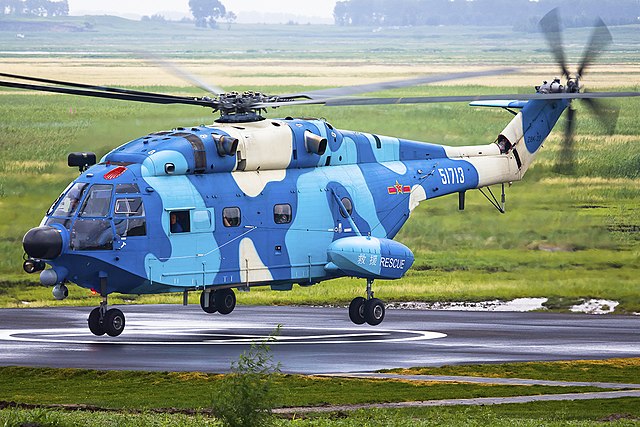
Changhe Z-8
Current Geopolitical Situation
“Thucydid’s trap” had been the recent byword to describe the geopolitical situation recently between the USA and China. Plans for the close future are relatively easy to dicern: PLAN’s ambitions include globally operating out to the first and second island chains so to be able to venture to the South Pacific, near Australia, the Aleutian islands, Straits of Malacca and Indian Ocean. It’s clearly the same focus as the USN, a “long arm in strenght” and conventional deterrence showdown. Between the current program of stealth guided missile destroyers equipped with long-range air defense missiles, more extensive anti-submarine capabilities like the Type 055 and their probable sucessors or improved variants (55A, B, C…) also depending on the future DDG-X program once the Zumwalt class has been cancelled.
The PLAN also wants more advanced, quiter, more versatile nuclear-powered attack and ballistic missile submarines, notably successors to the Type 096 ans well as more advanced AIP for their conventional attack submarine. But the bedrock of any large operation like the assault on Taiwan would be its four task forced based on the Type 001, Type 002, Type 003 and 004 carriers, helicopter carriers of the Type 075 and possible successors, large amphibious warfare vessels Type 071. On the second half of the 2020s it is likely China will continue its policy of building more, cheaper, multi-role capable frigates and corvettes, and for again, an operation against Taiwan, acesses to the area could be closed from recently acquited islands by fast littoral missile attack craft such as the Houjian, Houxin and Houbei classes. The recent upcoming years are also likely to see large scale decommissions of 1980s generation ships now recent ones are standardized and likely to use the same communication protocols and weaponry for better C3.
Some analysts suggests that even after decommission they are likely not to be BU as the Chinese tend to keep their ships long after and so would be still available to be converted as fast transports or fire support platforms (Luda class destroyers, older Frigates etc). Chinese nuclear deterrence is also quite capable thanks to its new type of nuclear ballistic missile submarines (SSBNs) watched over by Type 094 and Type 093 nuclear attack submarine. This would play the role of supreme insurance in case of conventional excalation. As said above, six means four at sea at all times, which is significant. For obvious security reasons is is currently unknown if these submarines has been already detected by the USN or its allies in the region.
However the new nuclear submarines are also capable of performing conventional strikes and special warfare requirements. The European Union was a provider for most of the current propulsion technology of PLAN’s ships and even submarines so the modernization has been on par in quality with European levels recently.
Current goals could be:
-Assert or defend China’s claims in maritime territorial disputes (and EEZ interpretation)
-Protect China’s sea lines of communications to the Persian Gulf (a crucial energy source for its military machine)
-Protect vital other trade routes for all that is imported (plus the completion of the “new silk road” on land).
-Making shows of strenght from the aleutians to the south pacific and indian ocean
-Play its part in anti-piracy missions from Gwadar or Seychelles, extend the capabilities of its Djibouti base
-Extend pacific support points for projection operations, both fleet and troops.
In the latter chapter, China considerably extended its fleet of resplenishment vesels and its testing designs for arsenal ships.
Also probably reinforce the cooperation between the PLAN and it’s Ro-Ro fleet and complete its range of civilian multipurpose vessels
And prepare its People’s Armed Forces Maritime Militia for bolder operations
PLAN’s Maritime Militia
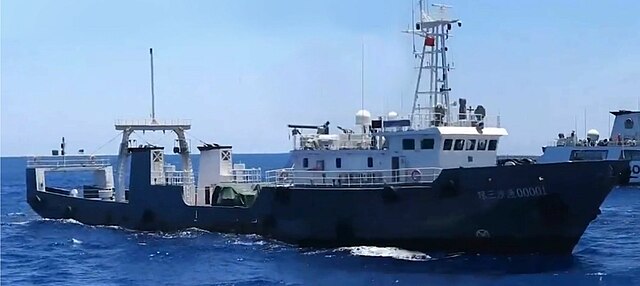
A maritime Militia supply ship, the “00001”. These vessels are mass produced on very similar designs.
Sun-Tsu would have approved: Xi’s “little blue men”: A warship is costly and sometimes an unarmed ship is able to perform useful roles in an agressive martime policy. The maritime militia composed of hundreds of relatively similar offshore fishing trawlers. Since their hulls were mostly painted blue and they always band together in a military manner, they are called by particularly annoyed neighbours of the South China Sea as the “blue fleet”, and are now a regular occurence in world’s medias. Their official name however, as long as its original and organization are known, is a Maritime Militia.
All in all, Chinese Fisheries GDP in US$ is worth 45.9 billion by 2004, US$ 6.6 billion in export value. The fleet is composed of c220,000 motorised vessels with 25,600 greater than 100 gt (100 tonnes) so offshore.
Organization
The Maritime Militia is also also called the Fishing Militia (中国海上民兵) part of the triade of maritime forces, with the China Coast Guard and PLAN. It is a tool in the hands of the Republic of China (PRC) ro achieve some goals. As of 2022 PRC and Vietnam are the only nations with officially established maritime militias. It is also referred as the People’s Armed Forces Maritime Militia (PAFMM) by the USN and these fleets are closely watched by satelittes. They were famouslt called the “little blue men” by Andrew S. Erickson of the Naval War College, given their propention to occupy non-chinese waters in these recent years. It was not a creation of the PRC, but oddly of the Nationalists, which after fleeing to Formosa had no fleet to speak of, and had the idea of enlisting their numerous fishermen to create a militia.
The CCP on its side also quickly instituted a national maritime militia command, uniting all local militias, and the creation of the Bureau of Aquatic Products institutionalized and strengthened the composition, functions and organization of the maritime militia thanks to already collectivized local fisheries (KMT militias were all the contrary). In addition, Bureau of Aquatic Products is headed and staffed by high-ranking PLAN officers maintening close bonds and communication s procedures with the PLAN as well as procurement and formation. These were partly influenced by the Soviet “Young School” of military theory which emphasized coastal defense over naval power projection for new communist powers, something which is a long-held idea from the Tsarist Navy, in turn inherited from post-1870 France, under the same name.
History
In the 1960s-1970s, the PLAN by default of a naval academy for this, setup several maritime militia schools attached to three main fleet headquarters: Qingdao, Shanghai, Guangzhou. The 1970s maritime militia never ventured far outised Chinese waters but by the later 1970s it gained a sovereignty support role and took a more active stance (even aggressive), causing the ire of its neighbors, notabl in the South China Sea. The USN was reported and started to watch its activities in the 1980s already after complains of allied Philippines and Thailand.
Their ain title of glory was the Battle of the Paracel Islands which opposed these to the Vietnamese Militia on 19–20 January 1974. The blue fleet provided help in carrying troops providing amphibious lift capacity to land on the islands. This episode was one factor that ultimately led to the 1979 Sino-Vietnamese war.
In the 2000s, the maritime militia, considerably reinforced and better trained as ever, conducted more bold operations, notably with physical interference with USN ships in the area, and incidents icreased with each time “unprofessional behaviour” meaning going across the path or ramming, bumping outright US or allied ships in the contested South China Seas.
In 2019, the US issued a clear public unequivoqual warning to China over the aggressive and unsafe action of both their their Coast Guard and maritime militia. The coast guard indeed in addition to the agressive fishing in contested EEZ around the South China Sea, deliberately try to enforce Chinese-claimed EEZ in contradiction to international law.
The maritime militia provoked countless incidents, and while beign apparently unarmed (but possible personal weapons by the crew), they had been flagged many times to delibertely point onboard high powered lasers at passing by military aircraft cockipts, with an attack on a Royal Australian Navy helicopter nearly resulting on its loss and causing wild protestations from Canberra.
In 2022, satellite images established a fleet of a hundred militia vessels permanently roaming the South China Sea, and this rise by July 2022 to 400 militia vessels.
Ships and tactics
These boats are generally of the offshore type, mostly professional maritime militia fishing vessels with a few external fishing boats, the Spratly Backbone Fishing Vessels recruited by the government via subsidy programs and acting as mercenaries. They are between 45 and 65 meters long with all equipment for fishing but it’s not heir main activity. The permanent flee notably is never seen doing so and rather is just an occupaction force. The ships are however managed by independent captains, though under overall government control, and these civilians are therefore excluded from the PLAN organization, and they could be part-time fishermen running their business. Ten ports hosts such fleet, notably in Guangdong and Hainan Provinces.
The maritime militia being part of the armed forces it always have been unarmed officially as of 2018, but still, these ships are using obstruction and violence via dangerous maneuvers, ramming, shouldering, while more professional vessels are equipped with large water cannons and non-lethal lasers. The are also equipped with navigation and communication equipment (including possibly crypted systems to communicate with the PLAN) and small arms at least for close protection is probably commonplace. There has even been reports of Maritime Militia units equipped with naval mines and AA weapons, elthough these are still rare occurences.
The communications systems however could be quite extensive, used to spy on other vessels nearby. Although fishermen supply their own vessels, core contingents operate military-grade mass-produced shipsn fitted out for pure militia work. Typical Features are:
-Reinforced bow for ramming
-High-powered water cannon
-More extensive communication suites
If this sophistication due to a new equipment and better training on one hand considerably help making more and more complex manoeuvers and tactics, this also had them uncovered more easily as government-sponsored actors, despite Beijing denegations. Thus as a “gray-zone” force, they are subjected to cause the risk of escalation with foreign navies. This presence is also one of the motivation for Vietnamn, Thailand, the Philippines and even Indonesia to increase their capabilities.
As for tactics, thes fleets are using for maritime rights protection, enforcing areas in disputed area, zones of jurisdictions, and monitoring, regulates foreign activities, especially opposite fleets, all in waters claimed by the PRC and contested by its neighbours. They saw action on Brunei, Indonesia, Japan, Malaysia, Philippines, Taiwan, Vietnam EEZ, both in the South China and East China Sea, and also deliberately counteracting the US-led Freedom of Navigation Operations (FONOPs).
In terms of “Greyzone Warfare” similar on the cybersphere to governments sponsored hackers or manipulating the opinion using “trolls”, the limits of action of thee militias is still matter to debate. CSIS and academic journals claim the militia takes part in anti-access and area denial missions, extensing these areas now in the western Pacific. Between law enforcement and fishing vessels the PRC spares the use of PLAN assets, while still achieving its goals without escalation, and gradually making good it claims, putting its neighbours and the US on a permament fait accompli notice. This militia uses legal ambiguity and long diplomatic arbitrations as a way to act in a relatively safe way.
“grey zone” tactics avoids to reach conventional war while providing “plausible denial” to Beijing, as these fleets could well be acting privately. They are used to harass foreign vessels and still claim themselves when asked over thier behavious by megaphone, “protecting local fishery zones”. The Chinese government also reserve the right to defend its own fishermen, and thus mobilizing domestic nationalism in case of resistance by foreign navies or own fishermen.
The “attack” on USNS Impeccable is one of such cases in 2009, but also the Senkaku Island incident in 2010, Scarborough Shoal standoff in 2012, Hai Yang Shi You 981 standoff in 2014, Natuna Islands incident in 2016 for citing only the most outstanding.
There is a question remaining:
In case of a conventional war (ie, invasion of taiwan in 2024, and declaration of war or active support for the island by the US and allies), would this Militia takes a more “hands one” approach and took their share of active warfare ? Technically, armed trawlers always had been part of maritime operations (as larger armed merchant vessels). It was the case in WWI and WWII and the British RN even commissioned decicated class of such vessels. With 50-60m and around 100 tons, these vessels are quite capable of being armed and take an active part in military operations, in various ways, but mostly with limited upgrades: A trawlers lacks for example the complex electronic support, communication and warfare equipments which are reserved to PLAN’s ship, but they can received guns (including stockpiles of decommissioned ex-soviet or 1950s ordnance), carry depth charges, as well as rocket launchers, operate drones, or be specialized in other roles, like amphibious carriers and supply ships for the PLAN and performing covert operations. Future will tell.
Composition of the PLAN: Classes, Typology, naming conventions, traditions…
| Composition as of 2023: | |
| Aircraft carriers | – 2+ (1 Fitting Out, 1 build) |
| Landing helicopter docks | – 3 |
| Amphibious transport docks | – 8 |
| Landing ship tanks | – 36 |
| Landing ship medium | – 36 |
| Ballistic missile submarines | – 8 |
| Nuclear attack submarines | – 12 |
| Attack submarines | – 58 |
| Destroyers | – 50 |
| Frigates | – 43 |
| Corvettes | – 72 |
| Missile boats | – 107 |
| Submarine chasers | – 26 |
| Gunboats | – 17 |
| Mine countermeasures vessels | – 36 |
| Replenishment oilers | – 16 |
| Auxiliaries (various) | – 233* |
Classes: A full array
Starting with four WW2 ex-soviet destroyers in the 1960s and early diesel-electric subs, Chine expanded both its naval industry, organization and capabilities several fold, with a vital phase in the 1980s and since the 2000s the largest expansion (in all classes) of any military service anywhere in the world today. As of 2023 given the annoucements made by the PRC the Navy reached about 70% of its “wished level”. Needs for two more task forces based around new carriers (004 and 005) means also a dozen ships in support, defensive (One SAM destroyer, one SSM, one ASW, one versatile, and four ASW frigates, one or two support ships). The amphibious components, especially compared to the USN is very, very far from its desired level. For example there are only three Type 075 landing helicopter dock (NATO Yushen class) which are comparable to US ones. The more numerous Type 071 amphibious transport dock (Yuzhao class) are smaller and more comparable to US littoral ships.
Chinese Missile Destroyers
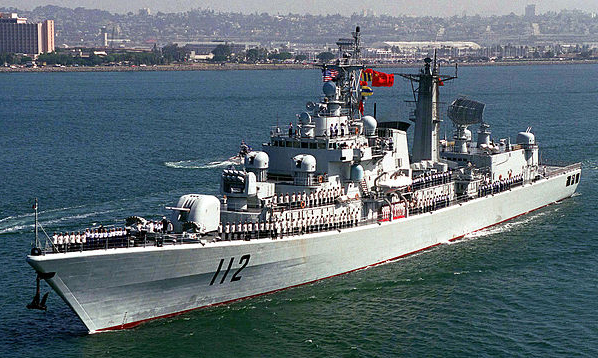
What really changed is the SCALE of class sizes. It is most spectacular for destroyers, a class which is already too large for developed European powers, which for various reasons focused on large frigates instead. It is matter of debate but the frontier between the two types are seomtimes blurry. It is not based on international convention and left to the choice of its naval staff. In the West, the name “destroyer” was reserved for exceptionally large and constly missile guided vessels which took the place of former cruisers. The “new normal” is the frigate, some being small as specialized (ASW) other being almost twice larger in tonnage (from 3,000 to 8,000 tonnes for example) and more versatile in firepower and roles. Plus in the context of economical crisis and vited budget, it’s safer for a naval staff to call a ship one class lower to sound “less costly”. Many Frigates in Europe are in capabilities destroyers in all but name. The problem is simple for the US which had only destroyers and no frigates (until the recent approval of the new Constellation class).
The separation is more obvious as far as surface ships in concerned with the Chinese PLAN.
Started with modified Kotlin class (Luda) as first true guided missile destroyers (now gone), early classes of properly modern Chinese built vessels of the Luhu, Luhai, Luzhou classes were limited to a pair of ships or a ship alone. These were mostly drafts, prototypes for larger series planned in the 2000s.
Construction started to ramp up with the Type 052C destroyers (Luyang II class) with 6 vessels, and reach near-Arleigh Burke levels with the next Type 052D destroyers (Luyang III class) 29 built so far, with several in completion. Future will tell if there will be a return and expansion/upgrade programme for this class or a brand new one.
30 is Still less than half of their US Counterparts and according to NATO and pentagon analysts, of lesser capabilities. These destroyers also progressed from 4,000 tp 8,000 tonnes standard, they are smaller than their US counterparts (9,500 tons for block III).
Cruisers disguised as destroyers: The Renhai class

As for an “answer” to the Ticonderoga class (now a 35 years old design), Chinese surprised alla analysts with “destroyer” by name, which most experts, between their tonnage and capabilities, considered “cruisers” in all but name. These are of course the 13,000t Type 055 destroyers (Renhai class). The closest in size and capabilities are recent JMSDF destroyers such as the Maya class (8,500 tonnes), while the South Korean Seljong the great (7,500 tonnes) are perhaps armed enough to maintain the comparison. The “return of the cruiser” is now a reality, and if nobody apart China seems to look after this disused class, perhaps the drive in Asia towards this type will provoke an announcement in the USA. Europe however id very unlikely to return to this standard due to its cost, but perhaps only after building a serious industry trans-national collaboration.
So with their 13,000 tonnes (estimated) “destroyers” China undoubtely have a class of eight ships without equivalent
PLAN Frigates
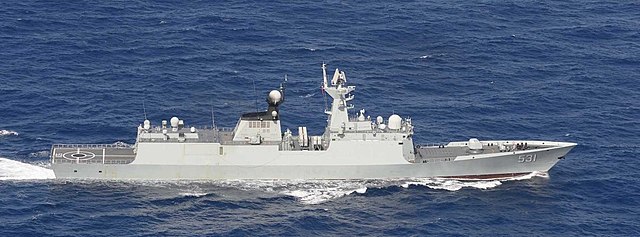
For this category also, the PLAN follows the same path as for destroyers. The soviet-era original Riga class derived ships are long gone, and the vessels built in the 1980s also, leaving completely original Chinese designs: Of the long serie of Type 053 (NATO Jianghu I, II, III, IV, V and Jiangwei I, II) which also was a “serie of prototypes” only one Type 053H1 and two Type 053H1G “light frigates” are still in service, and probably about to be retired in the latter 2020s. The term “light frigate” (which is official) is related to their tonnage, 1,730t, and still relates to the larger Type 053H3 light frigate (NATO Jiangwei II class) of 2,400t (8 ships).
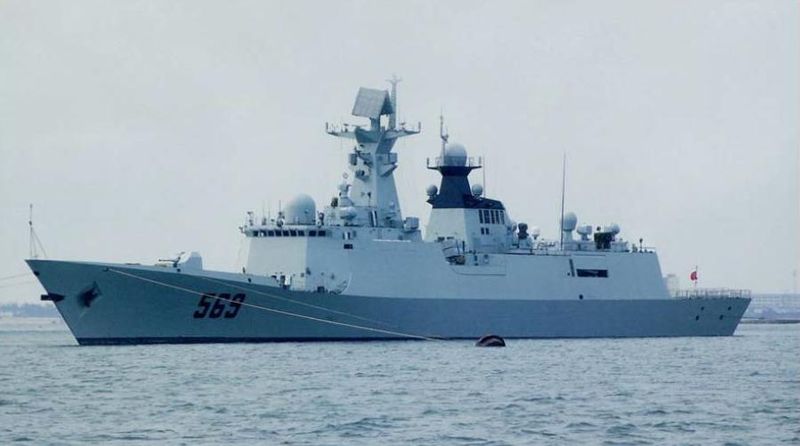
An important step was taken with the expansion of the Navy, in part to compensate for the lack of destroyers compared to the US, with more capable “frigates”, now classes as such, the 4,200t Type 054A (Jiangkai II class), 32 ships (3 currently in completion), which succeeded to two prototypes Type 054 (Jiangkai I class), 3,900t ships. 4,200 tonnes is respectable for a Frigate albeit mid-size compare to European models. As for comparison, the current USN Constellation in construction are rated as 7,300 tons ships fully loaded.
It’s certain that the PLAN is working on the next, probably larger Type 054B/C, and will probably catch up this format at the 7,000t rank in the later 2020s, consitent in Europe as “large frigates”. But when combining 43 frigates and 50 destroyers it’s more than enough surface tonnage to concern the US, which need to send more than half of its destroyers in the Pacific.
PLAN Corvettes

The same pattern was repeated here. The Chinese PLAN sports a force of 73 corvettes currently. Less capable than frigates, they are still missile ships with anough range to largely follow the fleet in the Pacific. Added to 43 frigates and 50 destroyers, this force starts to pile up against the 40+ or so mobilizable Arleigh Burke. The USN had no corvettes. In addition these Chinese corvettes were mas built based on an homogeneous design, the Type 056/056A corvettes. These are small but pretty versatile ships with two twin cell YJ-83 anti-ship missiles amidships a 8-cell FL-3000N SAM launcher, two triple ASW Torpedo Tubes against submarines and for close defence a 76 mm gun and two H/PJ-17 30 mm CIWS autocannons, a pretty rounded range of muli-threat capabilities, if communication allows to reach a greater combat management system.
So in the end, the 2020s PLAN seems homogeneous with the choice of a four-tiered classes (cruisers (not by name), destroyers, frigates and corvettes), all complementary, giving great flexibility in operations. Why risking a Renhai class when corvettes were available and ready to answer all threats in a less intensive environment ?
PLAN Submarines
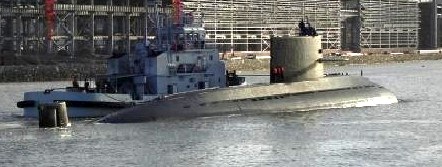 It is less patent for submarines, also a relative weak point in the PLAN’s composition. The Kilo-derived Type 039 submarines (Yuan class) of 2011-2019 comprises 13 boats, compared to cold war classes like Whiskeys and Foxtrots seems weak, but their capabilities are several fold above. The PLAN still not have an equivalent to the US Los Angeles class, the Shang class is indeed likely to evolve into quieter, large SSNs before the end of the current decade. More complex, it seems SSNs would need a longer learning curve compared to simpler surface ships like destroyers, which neary reached the top of their potential according to western experts. So the next class would probably be a large class, in order to replace the boats in reserve (Han class, Ming class).
It is less patent for submarines, also a relative weak point in the PLAN’s composition. The Kilo-derived Type 039 submarines (Yuan class) of 2011-2019 comprises 13 boats, compared to cold war classes like Whiskeys and Foxtrots seems weak, but their capabilities are several fold above. The PLAN still not have an equivalent to the US Los Angeles class, the Shang class is indeed likely to evolve into quieter, large SSNs before the end of the current decade. More complex, it seems SSNs would need a longer learning curve compared to simpler surface ships like destroyers, which neary reached the top of their potential according to western experts. So the next class would probably be a large class, in order to replace the boats in reserve (Han class, Ming class).
The soviet-era boats which traded quality for numbers are now all gone. Projection far overseas is not yet a priority for the submarine arm and thus, the use of 59 conventional attack subs (13 in reserve) makes sense to roam the “inner belt” between the East and south Chinea sea with incursions in the Philippines, Indian Ocean and Indonesian waters. But now 50% of the paciic is in reach with the latest generation. The Type 039A/B/C (2006-2020s) submarines are the first fo example to feature an AIP (Air Independent propulsion) and range is known from export versions, albeit the export S20 versions is perhaps downgraded. Yet still it is featuring a range of 8,000 nautical miles at 16 knots and 60 days of endurance, enough to reach New Zealand and Back.
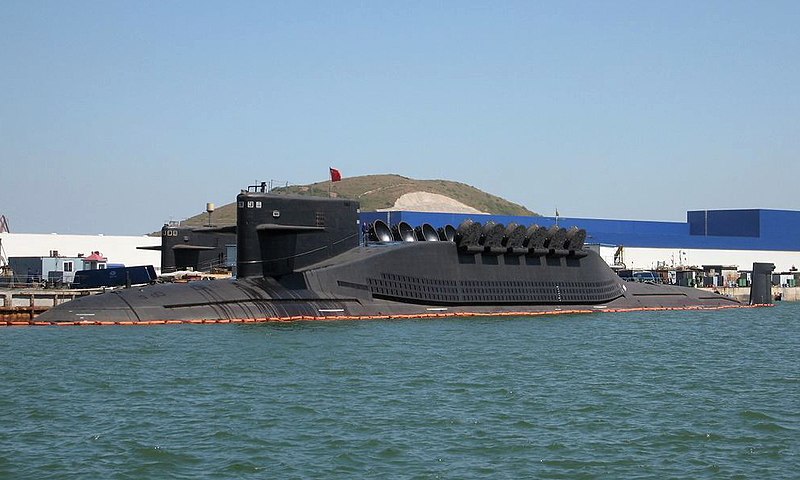
The fleet of current SSNs (6 +3 in reserve) of the Type 093/93A type is not impressive, of the scale of a European power like Britain or France. It is believed by most experts that this current 093 (first boat launched 2005) -NATO Shang class- is far more quieter than the “Han class” of the 1980s. In style and general outlook they are much closer to western standards, no longer on the “light” side for the Type 93 (6,100t) but with the more numerous Type 93A (3,600t) being much shorter compared for example to a French Barracuda (5,300 t) or British Astute (7,400 t).
The fleet of SSBNs is more impressive. The Xia class was a prototype, no discarded, and the current deterrence resting on no less that six Jin class (11,000t), which are comparable, albeit smaller, to European equivalents (Vanguard 15,900 tonnes; Triomphant 14,300 tonnes). Unlike these two powers which deterrence is resting on four boats to have for policy of having two operational at sea at all times, having six submarines gives Xi’s deterrence more leverage. The US however has 18 much larger Ohio class (18,750 tonnes), so thrice as many.
127 Coast Defence ships
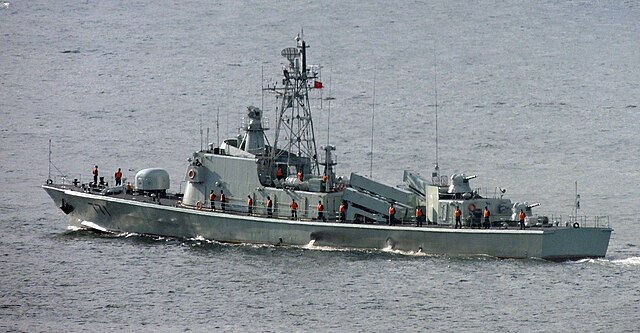
In a sense, a survival of cold war years when transitioning from a green water to a blue water navy, the PLAN kept a part of its former large coastal fleet made of large and smaller patrol ships. Having a substantial coast guard (see below), now the role of patrol has been externalized and what remained is the most proactive part of the defence, made of fast attack ships (FAC). This category is composed of five classes, three of missile FACs (Houbei, Houjian, Houxin), one of sub-chasers (Haiqing class) and one of gunboats (Shanghai III). The latter are rather old but still valuable assets for patrols, and long derived from a Soviet cold war design, but share little with these. The sub-chasers Type 037IS (Haiqing class) despite being 450 tonnes ships are well armed and classed as “corvettes” but their ASW array is not modern, between ASW rocket launchers and depth charges.
They are the last of several classes, the Type 037 Hainan-class (100+), Type 037 Haijiu-class (4), Type 037I Haiqing-class (one acquired by Sri Lanka). What is more interesting however is the modularity of their hull, that could be turned in other ships types, and in that case, Type 037IG Houxin-class missile boat (26 built) and Type 037II Houjian-class missile boat (8 built, 2 more construction)
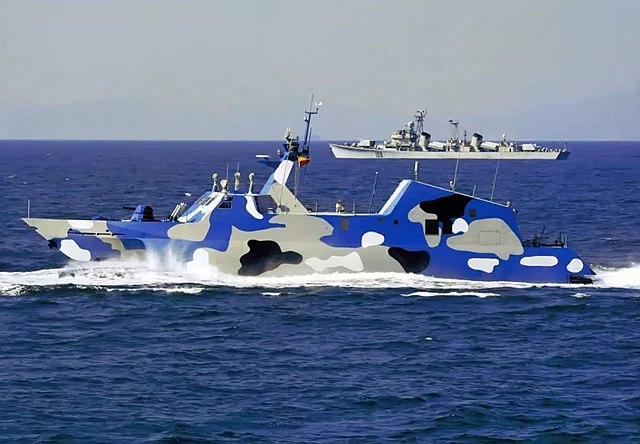
The FACs are quite interesting as well, showing the PLAN is ready (as was USSR before) to innovate. The Type 22 missile boat (Houbei class) are indeed catamaran types to achieve greater speed, something vital to the operation mode of these light attack vessels. 220 long tons their powerful set of diesel engines and waterjets allowed 36 knots (67 km/h; 41 mph). They are armed with eight YJ-83 antiship missiles, a derivative of the exocet. They were created to succeed former OSA-II soviet-era ships.
As for the other missiles boats described above (Type 037IG and II classes), they operate similar C-801 SSMs and C-802/803 models (YJ 83). With eight missiles each, a trio can deliver a saturation attack of no less than 24 sea-skimming mach 1.4 missiles at up to 180 km. The Type 022 had a stealthy shape added to its low profile to make detection more difficult.
Naming Conventions
The ship’s Naming Regulation was first issued by the Central Military Commission by November 3, 1978. It was revised by July 7, 1986 as the following:
–Aircraft carriers: Provinces (which are large enough to be considered as states).
–Nuclear-powered submarines: All named “Changzheng” (Long March) assorted with a number.
–Conventional submarines: All named “Chángchéng” (Great Wall) assorted with a number.
–Destroyers and frigates: Cities.
–ASW ships/OPVs: Countries.
–Tank landing ships/dock landing ships: Mountains.
–Infantry landing ships: rivers.
–Replenishment ships: Lakes.
Classes of ships
Chinese Aircraft Carriers
 Liaoning -Type 001 (2011)
Liaoning -Type 001 (2011)
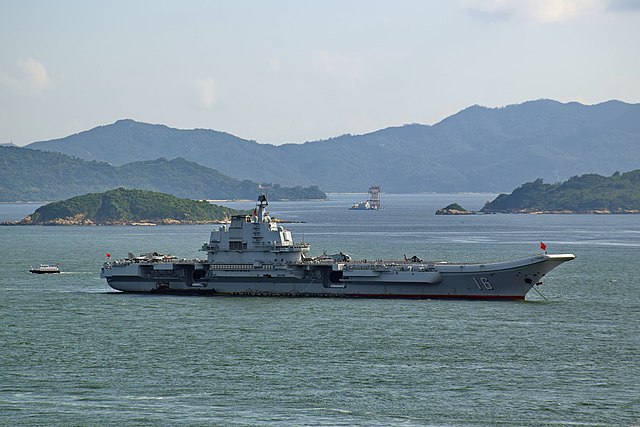
Liaoning (辽宁舰, from a province) is the Chinese Type 001 aircraft carrier, the very first one. She was commissioned and originally classified as a training ship to really quickstart the Chinese with aircraft carrier operations. By late 2018 however enough experience had been acquired and enough modifications to shift to a combat role since 2019. It is assumed she will keep both roles, alternating between training and active fleet exercizes and combat scenarios. In the case of a Taiwan invasion in 2026 or 2027, it would likely be deployed frontline.
Her story is quite quircky: She was originally laid down in 1985 for the Soviet Navy, a second Kuznetsov-class aircraft carrier named “Riga”. Launched on 4 December 1988, renamed “Varyag” in 1990 just before the Soviet Union collapse. After 1991 construction was halted. Budget-stripped, the new government tried to sell her to Ukraine. But it went to nil. She was put on the international market, and purchased eventually in 1998 by a private company with official intention to complete her as a massive floating hotel casino berthed at Macao. The ship transited to the China Sea, and soon enough the cover story started to fade out as, tracked by satellites, she was clearly towed to the (main arsenal and Yard) Dalian in northeast China. At this point the story was still the one officially stated.
But of course instead she was completed after many, many more years (and perhaps trips of Russian engineers in between), and commissioned at last into the PLAN as “Liaoning” on 25 September 2012, 27 years after being laid down. Her official designation was changed to Type 001. In November 2016 Commodore Li Dongyou stated that she was combat-ready. In 2018 as seen above, she was also declared capable of fleet operations.
https://en.wikipedia.org/wiki/Chinese_aircraft_carrier_Liaoning
 Shandong -Type 002 (2017)
Shandong -Type 002 (2017)
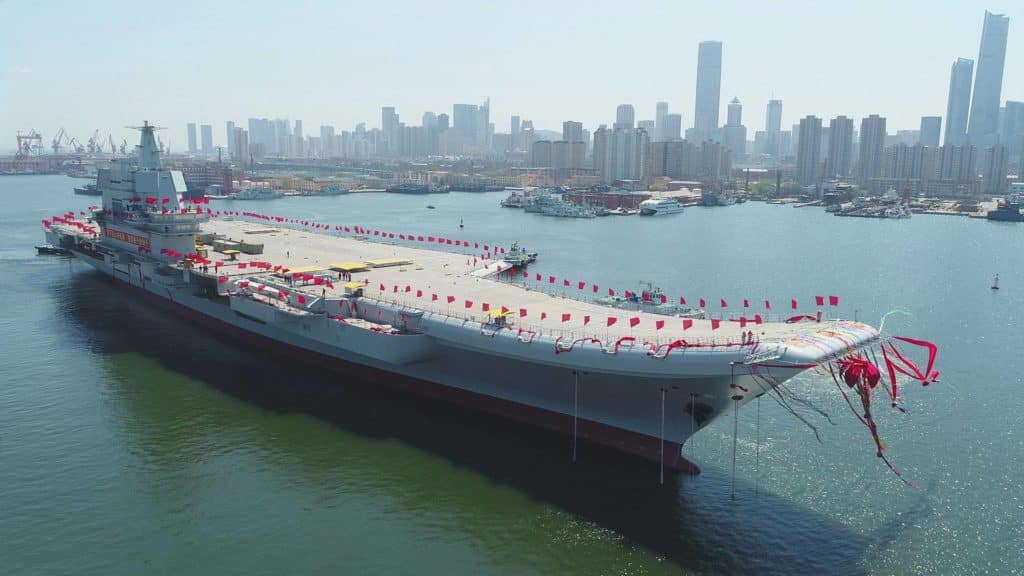
Back in April 2017, a brand new massive aircraft carrier was launched, and it was Chinese, unnamed while at Dalian. The PLAN at the time was still “only” rated as the world’s third largest. This brand new carrier arrived to back the 20-years old Liaoning. The Shandong (ex 001A). Completed on 25 April 2018, she was Commissioned on 17 December 2019 under capt. Lai Yijun, which commanded previously the frigate Lianyungang. So what happened since four years ?

She was deployed after shakedown and training, probably years of fixes, cruises, more trials and in between many weapons and aicraft qualificaitions, in April 2023, to the major fleet exercizes “United Sharp Sword” in the Philippine Sea, simulating air and sea strikes on Taiwan from Okinawa according to Japanese MoD. She had 120 deckings and launchings in 48 hours as she was escorted by three other warships and a support vessel. The task force came to 230 km of Japan’s Miyako Islands whereas its J-15 fighters came on east of Taiwan loaded with live ammunition and similating several simulated strikes. Shandong was guarded by a Type 055 destroyer, two Type 052D destroyers, two Type 054A frigates, and a Type 901 replenishment ship. Later they were further in the Pacific, coming 600 km of Guam and back to the South China Sea via the Bashi Channel. We’ll keep the post posted along the years.
 Fujian -Type 003 (2022)
Fujian -Type 003 (2022)
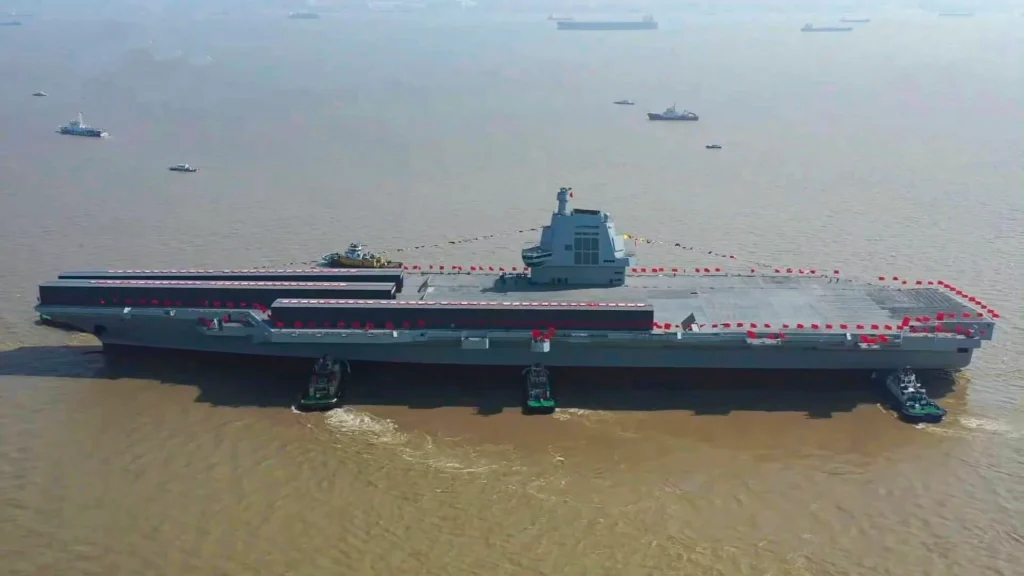
Fujian pending completion, with two large boxes hiding her electromagnetic catapults to preying eyes. (south china morning post)
Fujian (福建舰 after another great ancient province) is the Type 003 class aircraft carries (NATO Fujian-class). She was a brand new type of carrier Built for PLAN, laid down somewhere between March 2015 and February 2016, and launched on 17 June 2022. She was was not being completed yet, still fitting out as late 2023. It is expected probably by mid-2024 at the earnest, or before to constitute a three carrier group force ready for the invasion of Taiwan.
Type 003 is a landmark for Chinese naval construction as she is its first fixed-wing aircraft carrier, not only sporting a fully indigenous design unlike the two previous Liaoning and Shandong, but also record size (80,000 tonnes fully loaded, 316 m long) and featuring a CATOBAR system plus electromagnetic catapults instead of a ski ramp.
She is again her own class, a gradual step towards a larger design. The fourth indeed, still unnamed, is nown called by various experts “Type 004” meaning she is yet another scaled up ship.
 Unnamed -Type 004 (2024)
Unnamed -Type 004 (2024)
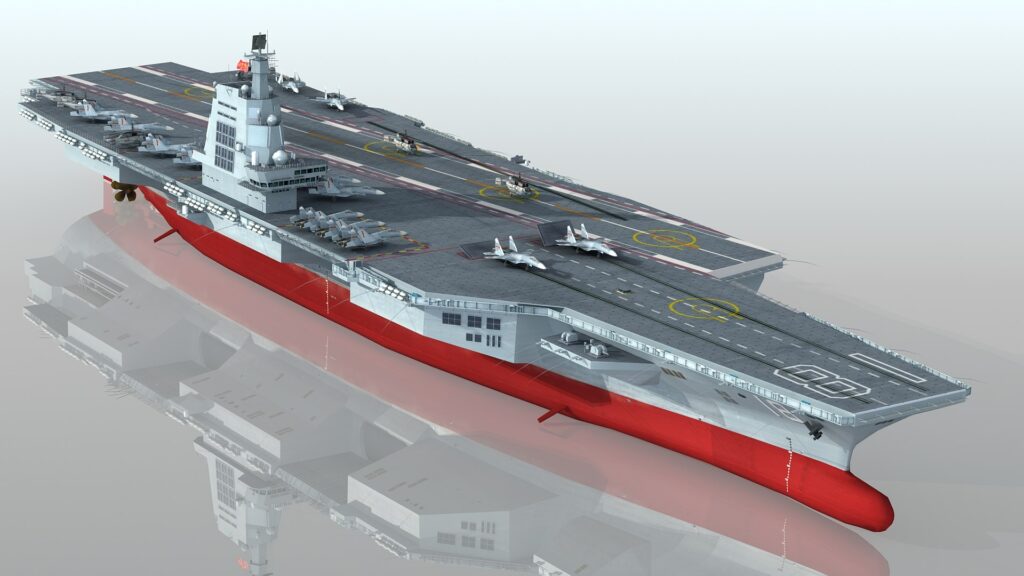
A rendition of the Type 004 (Turbosquid).
The Type 004 aircraft carrier is planned and describe so far as an iteration on the preceding Type 003 with integrated electric propulsion system, electromagnetic launch catapults, larger and first with a nuclear marine propulsion to also power as planned laser weapons and railguns under development. As of 2017 completion is expected for 2027-2028 with up to four in her class being planned.
The government announced having spent 22 billion (US$3.3 billion) to develop two prototype molten salt nuclear reactors (described as safer than conventional fusion ones), built at Wuwei, Gansu province. Construction of 004 started by late 2017 on the yard itself, Jiangnan Shipyard, scaled up for the new ship planned, with setting up of new 1600-ton gantry cranes. By March 2018 a leak from China Shipbuilding Industry Corp. announced the future nuclear-powered Type 004 as part of its portfolio.
The Type 004 for the moment is likely expected to operate J-15 and J-31 fighters, as well as the Xian KJ-600 airborne early warning and control (clone of the Hawkeye) as well as yet unknown ASW aircraft plus stealth attack drones. It seems the J-20 aircraft is too heavy for the new carrier in addition of not having folding wings, plus a water spray sensitive stealth coating.
Expecting commission date: 2028 is likely planned, although 004 is so far the most ambitious and complex naval program ever undertaken in the whole of Asia…
Future plans for PLAN’s supercarriers
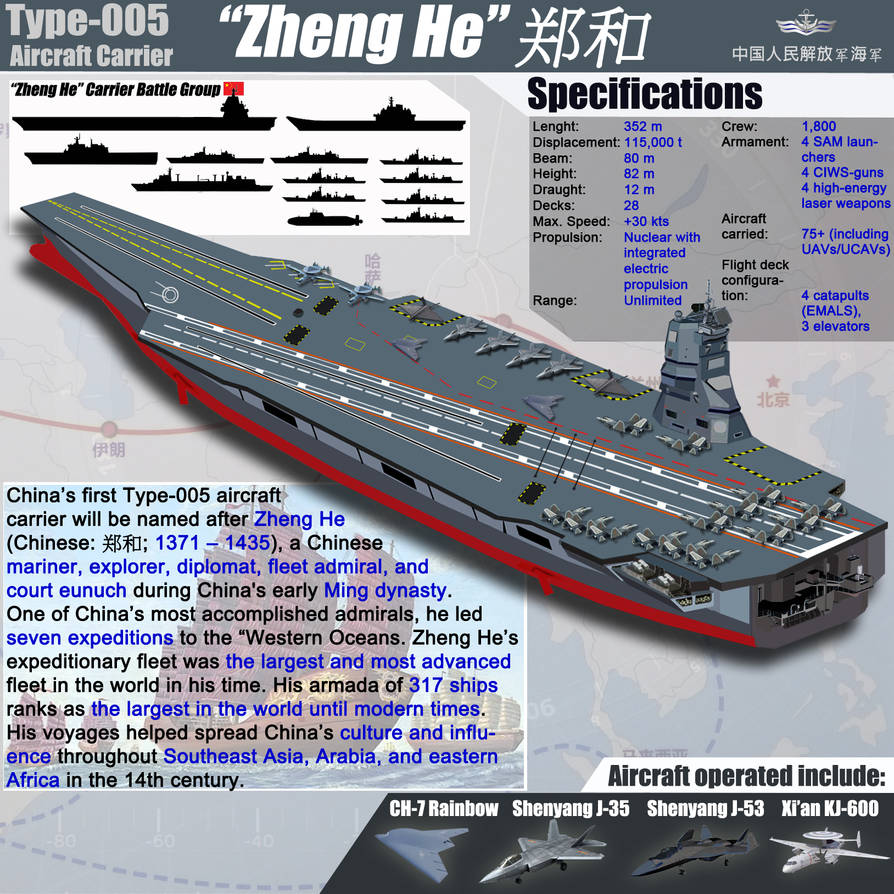
For the fun, rendition of “Zheng He”, a Ford-like 110,000t supercarrier. src: infoflawvour on deviantart.
The need to operate larger carriers groups to face attrition, as well as a possibily navalized version of the J-20 might push China to create another, larger class of supercarriers in the 360m, 120,000 mark. But it’s not before the mid-2030s at best for the moment. Given its yard capabilities, only one yard can buil the current 004 at the moment, and a class of four was announced, meaning by five years interval the last of the current new class would not be out of the slipway before 2035 at the earnest.
The remaining question is, would three carriers would be enough to launch an attack on Taiwan on 2027 as planned ?. It is still possible that 004 would be operational by then if all priorities are given to this program.
28 Chinese Destroyers
After the modernized Ashan class, discarded in 1991, the Luda class destroyers from 1966-77 were still in service. Since then were built the two Luhu class (1991), the Luhai class’s Shenzen (1999), eight Luyang class (2004), two Luzhou class (2006) and the actual Luyang III class (2014) with five commissioned and height more in completion.
To this, four ex-Soviet Sovremenny-class destroyer were acquired and commissioned in 1999 to 2006.
But by far the most impressive, which gives a good measure of Chinese intentions is the Renhai class (Type 055 destroyer) in completion for 2018-2019. These are 10,000 tonnes destroyers, presented to the press by admiral Yin Zhuo like a ‘game changer in naval warfare’, an equivalent of the US Arleigh Burke class.
 Luda class, Type 051 (1970)
Luda class, Type 051 (1970)
The oldest of the bunch, six missile destroyers, 1st generation, heavily modified 1950s Soviet Kotlin class-inspired vessels, no longer active (and thus not in this count). Despite their venerable age they had been modernized and still possess some military value. Apart two scrapped three of the Type 051 are now preserved as museum ships. Meaning if needed they could be reactivated in case of emergency, with scenarios of high intensity typically like a US response to the Taiwan invasion.
More serious proposition (counted this time) ar the following, of which most are preserved as attraction of museum ship, again not to enter an active reserve.
Type 051 Luda II: Helicopter destroyer (Luda II) (1971), North Sea Fleet, museum ship in Qingdao.
Type 051D: Xining, Nanchang, Zhonghua, Chongqing, Zunyi, Guilin, all preserved but the last to be expended as target ship.
Type 051DT: Kaifeng, Dalian,
Type 051Z: Hefei,
Type 051GT: Zhanjiang, Zhuhai, all also preserved as “museum ships”.

Chinese transition destroyers: The Luhu clas destroyers constituted in 1993 a significant improvement over the Luda class, a domestic design that approached the capabilities of Western detroyers, but made to achieve this goal extensive use of foreign technologies still accessible to the PRC before the 1989 incident and subsequent ban. They were also the first Chinese DDs to use gas turbine engines, and to be fitted with a a integrated combat system. Although impressive compared to previous designs, it must be compared to the contemporary Arleigh Burke and Kongo designs.
 Luhai class, Type 051B (1999)
Luhai class, Type 051B (1999)
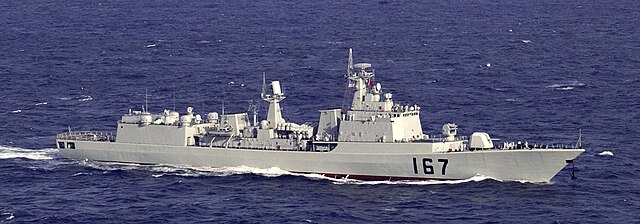
Santa Rita, Guam – 22 Oct. 2003 – The People’s Liberation Army (PLA) Navy guided missile destroyer Shenzhen (DDG 167) enters Apra Harbor, Guam. The Shenzhen and the oiler Quinghai Hu (AO 885) are making the People’s Republic of China’s first ever port call to Guam. U.S. Navy photo by Photographer’s Mate 2nd Class Nathanael T. Miller
The Type 051B destroyer (NATO Luhai class) is a bit of a transitional prototype with a single ship, Shenzhen (167) completed so far. Built in 1996–1999 this 7,000t destroyer also became the largest
surface combatant that China had ever built in this category. It is essentially an enlarged Luhu-class but with slope-sided hull to reduce radar signature. It has been succeeeded by the Type 052B destroyer, added to four Soviet-built Sovremenny-class destroyers purchased as well to boost the numbers.
 Project 956E/EM (Sovremenny, 1994)
Project 956E/EM (Sovremenny, 1994)
Hangzhou, Fuzhou, Taizhou, Ningbo
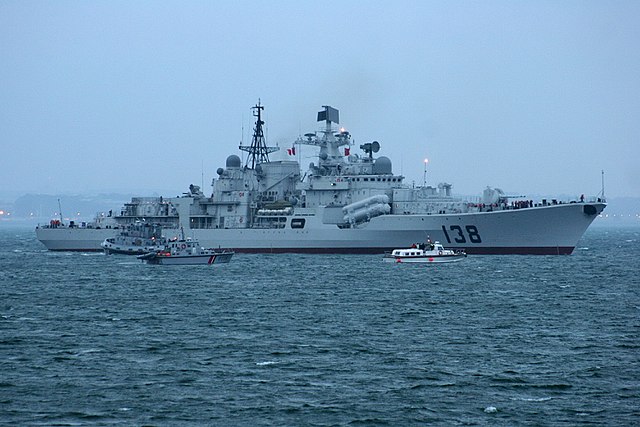
Taizhou out of St Petersburg
The PLAN in 1999 decided also to make a surprising move and directly order the construction of brand new, most recent evolution of the Sovremenny class destroyer (a soviet late 1970s design) to boost the numbers, adding as many innovations and home made systems for them to stay relevant for another decade and more. Four were purchased in all, coming in two pairs, delivered in December 1999 and November 2000 as Project 956E for the first ones. They had improved electronic. In 2002 the next two were also purchased as Project 956EM, built and launched in late 2005, and the other in 2006, in service since then in the East Sea Fleet.
Project 956E: Aft AK-130 removed, four AK-630 CIWS replaced by two Kashtan CIWS gun/missile systems coupled with a 3R86E1 command module and two 3R87E combat modules.
Project 956EM: They were armed with the latest version of the SS-N-22, called in China 3-M80MBE and developed on Chinese funds according to Russian sources with a range of 200 km (120 mi). Same for the SA-N-12/SA-17 SAM, to be replaced by a new variant studied by China and Russia.
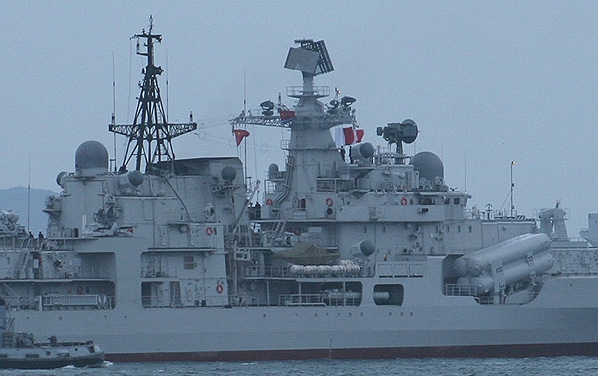
Bridge of the Project 956EM
In 2006, exports noted extra spheres, painted white, added atop of the superstructures. The ships appeared to have been updated with the domestic HN-900 Data link and SNTI-240 (likely) Satcom.
By mid-2014 they underwent a midlife upgrade program, starting in 2016 with Hangzhou upgraded with two quad YJ-12A supersonic missiles and a VLS with 48 SA-N-12 SAMs and 4×8 cell (32 cells) for HQ-16C or Yu-8 anti-submarine missiles. They were suspended Soviet vessels. In post-collapsed Russia, funds were lacking to complete them.
Hangzhou (ex-Vazhny) laid down 4 November 1988, launched 27 May 1994, comp. 25 December 1999
Fuzhou (ex-Vdumchivy), laid down 22 April 1989, launched 16 April 1999, comp. 20 November 2000
Taizhou (ex-Vnushitelny), laid down 3 July 2002, claunched 27 April 2004, comp. 28 December 2005
Ningbo (ex-Vechny,) laid down 15 November 2002, launched 23 July 2004, comp. 27 September 2006
 Type 052B Luyang I class (2002)
Type 052B Luyang I class (2002)
Guangzhou, Wuhan
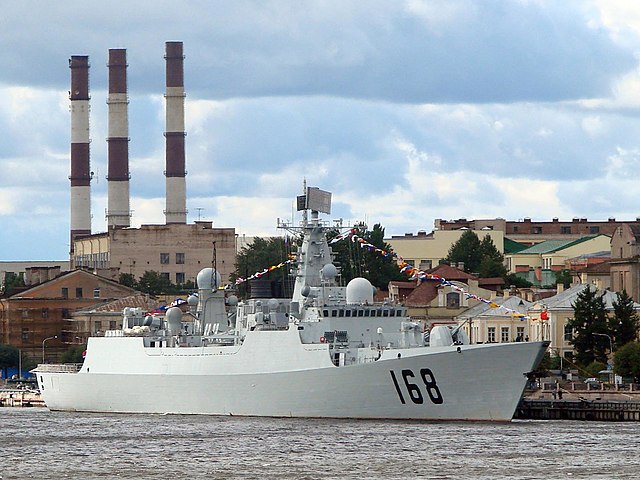
The Type 052B (NATO Luyang I) are the really first modern PLAN destroyer design, with better stealth features and incorporating medium-range air defence capability (Russian Shtil-1/Buk or SA-N-12). This was soon obsolete when entering serviceto US or JMSDF standards, but represented a considerable setp forward, precursor to later large production Chinese air warfare destroyers.
Only Guangzhou and Wuhan were commissioned in July 2004, now in service with the South China sea.
Brief specs: 7,000 tons, 155 x 17 x 6 m, CODOG with DA80 gas turbines and MTU 1163 TB 83 diesels= 29 kn RA 4500 nm/14 kn, crew 280.
Armed with 16× YJ-83 SSM, 48× Shtil-1 SAM, H/PJ87 100 mm main gun, 2× Type 730 CIWS, 4× ASWMRL, 2×3 B515 324mm Yu-7 ASWTTs. Helicopter Harbin Z-9.
 Type 051C (Luzhou class)
Type 051C (Luzhou class)
Shenyang, Shijiazhuang
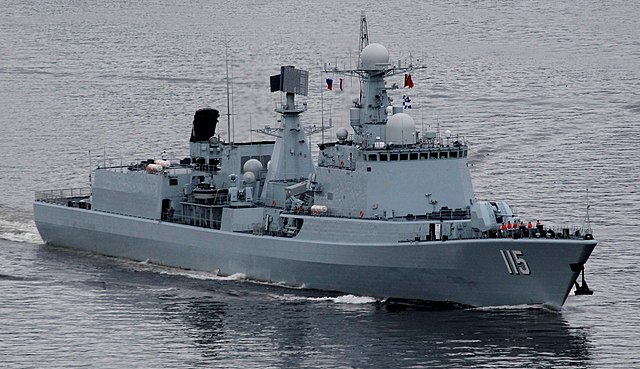
The Type 051C destroyer (NATO reporting name: Luzhou class) is a long-range air-defence guided-missile destroyer built by China in its ongoing effort to create a true blue water navy. The ship uses the hull design of the older Type 051B (Luhai class), but is equipped with the advanced Russian S-300FM air defence missiles systems.
The Type 051C destroyer saw only two launched, commissioned with the North Sea Fleet. Construction at Dalian was revealed in 2004. This class lacks the stealthier radar cross-section of the 52B or 52C and less advanced steam turbine propulsion. The Type 051C is a stop gap clas before more mature hull designs with proven SAMs
Quick specs:
7,100 tons, 155 x 17.1 x 6 m, 2 steam turbines, perf. unknown. Armed with 48× S-300FM (SA-N-20) VLS SAM, 8× YJ-83 SSM, 100 mm DP gun, 2× Type 730 30 mm CIWS, 2×3 324 mm Yu-7 ASWTT, 4 decoy launchers, Kamov Ka-28 Helix helicopter.
 Type 52C (Luyang II) (2003)
Type 52C (Luyang II) (2003)
Lanzhou, Haikou, Changchun, Zhengzhou, Jinan, Xi’an
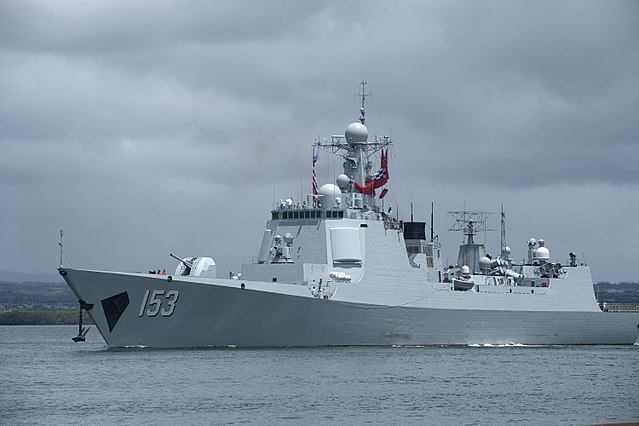
The Type 052C destroyer (NATO Luyang II) were the first with dixed active electronically scanned array (AESA) radar and VLS for area air defence capability.
The first two, Lanzhou and Haikou, were laid down at Jiangnan Shipyard, Shanghai in 2002, commissioned in 2004, 2005 and construction of four more resumed after relocation of the shipyard, for six operational as of 2019.
Same hull design as the Type 052B destroyer with more advanced stealth features
Quick specs:
7,000 tons, 155 x 17 x 6m (508 ft 6 in, 55 ft 9 in, 19 ft 8 in). Powered by CODOG, DA80 gas turbine, MTU 20V 956TB92 diesels 29 knots, RA 4,500 nm. Crew 280.
VLS 48 HHQ-9 SAM, 2×4 YJ-62 SSM, 100 mm PJ-87, 2× 30mm Type 730 CIWS, 2×3 ASWTT, 4 RLMs, Kamov Ka-28 helicopter, hangar.
 Type 052D destroyer (Luyang III) (2013)
Type 052D destroyer (Luyang III) (2013)
Kunming, Changsha, Hefei, Yinchuan, Xining, Xiamen, Ürümqi, Guiyang, Nanjing, Hohhot, Taiyuan, Chengdu, Qiqihar, Shaoxing | Zibo, Tangshan, Suzhou, Huainan, Nanning, Zhanjiang, Jiaozuo, Baotou
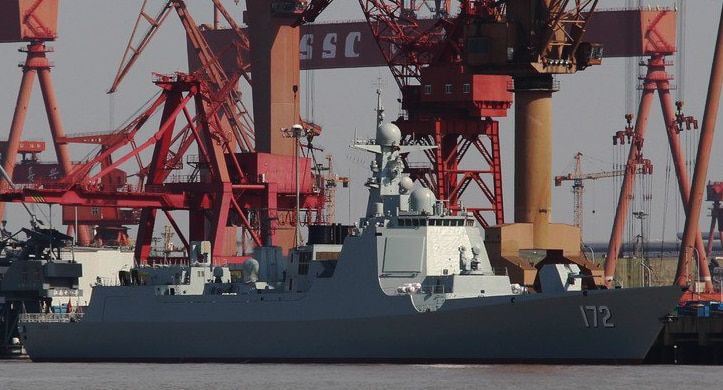
CNS Kunming, DDG-172 (Luyang III class or Type 052D destroyers)
The Type 052D destroyer (NATO/OSD Luyang III-class destroyer) are a larger variant of the Type 052C with canister-type VLS and flat-panelled AESA radar. It is the first dedicated multi-role destroyer of the PLAN, divided between the Type 052D (Kunming, Changsha, Hefei, Yinchuan, Xining, Xiamen, Ürümqi, Guiyang, Nanjing, Hohhot, Taiyuan, Chengdu, Qiqihar, Shaoxing) and the Type 052D “stretched” (no new NATO designation: Zibo, Tangshan, Suzhou, Huainan, Nanning, Zhanjiang, Jiaozuo, Baotou). The last was commissioned in May 2022.
Quick Specs:
7,500 tons FL, 157/161m ext x 17 x 6 m. CODOG 2x QC-280 gas turbines, 2× MTU 20V 956TB92 diesels 30 knots 4,500 nmi.
Armament: 130 mm, HQ-10 SAM (24), VLS GJB 5860-2006 (48)/HHQ-9 SAM/YJ-18 SSM/CY-5 ASW, Type 730/1130 CIW, Helicopter, hangar
 Type 055 destroyer (Renhai class) (2017)
Type 055 destroyer (Renhai class) (2017)
Nanchang, Lhasa, Anshan, Wuxi, Dalian, Yan’an, Zunyi, Xianyang

Assimilated by their capabilities to cruisers by the West. Largest warships ever built in China aside the LHDs and aircraft carriers. Designed for saturation attacks and as flagships with extended CiC facilities. Currently 8 are in service or likely to be so soon. They are by their size, tonnage, power and capabilities, classed as guided-missile cruisers per NATO/OSD standard. A fully multi-mission design they are mainly intended as area air defence, with extensive anti-submarine warfare capabilities for blue-water expeditionary missions and primary escort for aircraft carriers. They are currently compared to the Ticonderoga-class cruisers.
Quickspecs: 12-13,000 t, 180 x 20 x 6.6 m. Power 6× QD-50 turbine generators 30 MW COGAG, 4× QC-280 gas turbines 112 MW 30 knots RA 5,000 nmi crew 300+
Armament H/PJ-38 130 mm gun, H/PJ-11 CIWS, HQ-10 SAM (24), 112 VLS (HHQ-9, YJ-18, CJ-10, YJ-21), 2×3 Yu-7 TTs, 2 Harbin Z-9/Changhe Z-18, hangar
 Future destroyers and Cruiser programmes
Future destroyers and Cruiser programmes
To place the recent growth in perspective, between 2010 and 2018, 24 destroyers were launched (4x 052Cs, 16x 052Ds, 4x 055) compared to 10 between 1990 and 2010 with only two of the Aegis-type 052C class. So the first point to assume is that the growth would maintain its exponentional path at least for the next two years, unless the naval staff decides its escort force is enough to cover four taks forces for the invasion ot Taiwan and yards are redirected towards amphibious warfare ships.
As of today, for example, there are only eight Type 055 large destroyers, assumed to face about 11 interime modernized Tico (if all are committed in the Pacific) while the remaining 11 are either in reserve pending decommission in 2023-2027 (17 ships). Both the early blocks Arleigh Burke and Ticonderoga are to be replaced by the new DDG-X in development, with an expected service date by 2033 at the earnest. To compared with the Type 055, CG-52 – 73 sports two 61 cell Mk 41 vertical launch systems with 122 missiles (7 types) and 2×4 RGM-84 Harpoon missiles canisters. Just based on missile numbers alone, the 055 got more, but its comparing apples with cabbage.
Between Dalian and Jiangnan at the current rate, five destroyers might be built yearly in 2024, 2025, and 2026. Analysts expects a total of 12x 055/055A class destroyers, so eight followed by a batch of six 055A class. The 052D is expected to gain another c20 units to be followed by a 052E variant. The 055A and 052E are also expected to incorporate partial or full electric propulsion.
What is certain is that to counter c40 Arleigh Burke and 11 Ticonderoga, all AEGIS capable, China needs to have at least 50 AEGIS destroyers and the current projections are that 55 should be attained in 2027. It’s possible also to multiply cheaper AEGIS platforms, China could extent its shipyards capabilities in order to have 24 smaller 054B Type destroyers also by 2030.
(To come next: Chinese Frigates, submarines, corvettes, FACs, OPVs, amphibious ships, coast guard ships)
49 Chinese Frigates
32 Chinese Corvette
109 Missiles Boats
67 Amphibious ships
94 Submarines Chasers
68 Submarines
289 Misc. ships
Links/Sources
Links
Generic
thediplomat.com/2019/02/predicting-the-chinese-navy-of-2030/
wikipedia – People’s Liberation Army Navy
PLAN ships list as of 2023
PLAN’s naval air force
navalanalyses
About auxiliaries
csis.org/ first-battle-next-war-wargaming-chinese-invasion-taiwan
news.usni.org Ro Ro exercizes by Sam LaGrone and HI Sutton
janes.com chinese-military-using-commercial-ro-ro-shipping-to-enhance-its-amphibious-capabilities
jamestown.org/ ramping-the-strait-quick-and-dirty-solutions-to-boost-amphibious-lift/
asia.nikkei.com China-mobilizes-civilian-ferries-for-Taiwan-invasion-drills
wikipedia.org/ industry_in_China
sinodefenceforum.com
Illustrations, profiles: on shipbucket.com
on egloos.zum.com – Chinese MIG29

 Latest Facebook Entry -
Latest Facebook Entry -  X(Tweeter) Naval Encyclopedia's deck archive
X(Tweeter) Naval Encyclopedia's deck archive Instagram (@navalencyc)
Instagram (@navalencyc)





 Austrian Navy
Austrian Navy French Navy
French Navy Royal Navy
Royal Navy Armada Espanola
Armada Espanola K.u.K. Kriegsmarine
K.u.K. Kriegsmarine Dansk Marine
Dansk Marine Nautiko Hellenon
Nautiko Hellenon Koninklije Marine 1870
Koninklije Marine 1870 Marinha do Brasil
Marinha do Brasil Osmanlı Donanması
Osmanlı Donanması Marina Do Peru
Marina Do Peru Marinha do Portugal
Marinha do Portugal Regia Marina 1870
Regia Marina 1870 Nihhon Kaigun 1870
Nihhon Kaigun 1870 Preußische Marine 1870
Preußische Marine 1870 Russkiy Flot 1870
Russkiy Flot 1870 Svenska marinen
Svenska marinen Søværnet
Søværnet Union Navy
Union Navy Confederate Navy
Confederate Navy Armada de Argentina
Armada de Argentina Imperial Chinese Navy
Imperial Chinese Navy Marinha do Portugal
Marinha do Portugal Mexico
Mexico Kaiserliche Marine
Kaiserliche Marine 1898 US Navy
1898 US Navy Russkiy Flot
Russkiy Flot French Naval Aviation
French Naval Aviation Russian Naval Aviation
Russian Naval Aviation Sovietskiy Flot
Sovietskiy Flot Royal Canadian Navy
Royal Canadian Navy Royal Australian Navy
Royal Australian Navy RNZN Fleet
RNZN Fleet Chinese Navy 1937
Chinese Navy 1937 Kriegsmarine
Kriegsmarine Chilean Navy
Chilean Navy Danish Navy
Danish Navy Finnish Navy
Finnish Navy Hellenic Navy
Hellenic Navy Polish Navy
Polish Navy Romanian Navy
Romanian Navy Turkish Navy
Turkish Navy Royal Yugoslav Navy
Royal Yugoslav Navy Royal Thai Navy
Royal Thai Navy Minor Navies
Minor Navies Albania
Albania Austria
Austria Belgium
Belgium Columbia
Columbia Costa Rica
Costa Rica Cuba
Cuba Czechoslovakia
Czechoslovakia Dominican Republic
Dominican Republic Haiti
Haiti Hungary
Hungary Honduras
Honduras Estonia
Estonia Iceland
Iceland Eire
Eire Equador
Equador Iran
Iran Iraq
Iraq Latvia
Latvia Liberia
Liberia Lithuania
Lithuania Mandchukuo
Mandchukuo Morocco
Morocco Nicaragua
Nicaragua Persia
Persia San Salvador
San Salvador Sarawak
Sarawak Uruguay
Uruguay Venezuela
Venezuela Zanzibar
Zanzibar Warsaw Pact Navies
Warsaw Pact Navies Bulgaria
Bulgaria Hungary
Hungary

 Bundesmarine
Bundesmarine Dutch Navy
Dutch Navy Hellenic Navy
Hellenic Navy Marina Militare
Marina Militare Taiwanese Navy
Taiwanese Navy Chinese Navy
Chinese Navy Indian Navy
Indian Navy Indonesian Navy
Indonesian Navy JMSDF
JMSDF North Korean Navy
North Korean Navy Philippines Navy
Philippines Navy ROKN
ROKN IDF Navy
IDF Navy Royal New Zealand Navy
Royal New Zealand Navy Egyptian Navy
Egyptian Navy South African Navy
South African Navy

































 RN
RN
 Marine Nationale
Marine Nationale
 Soviet Navy
Soviet Navy
 dbodesign
dbodesign